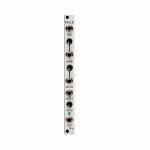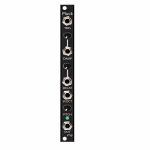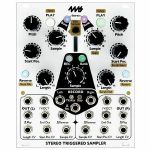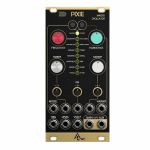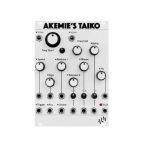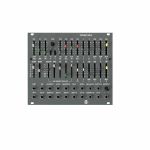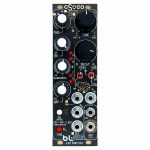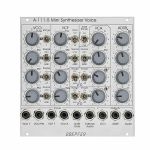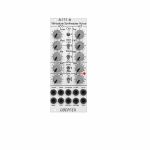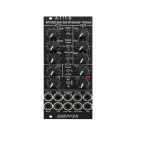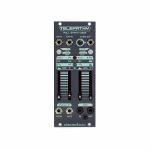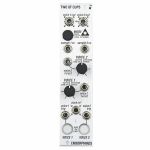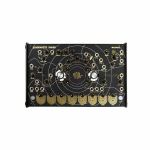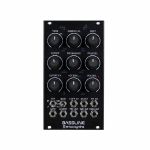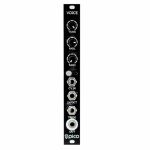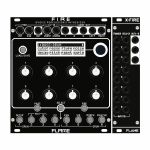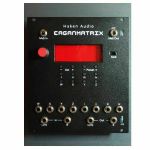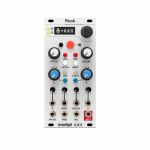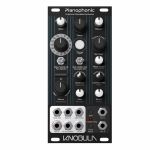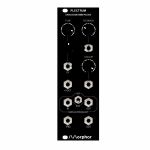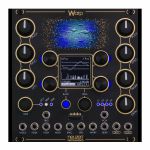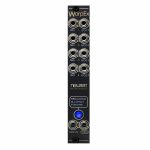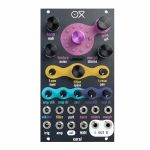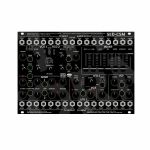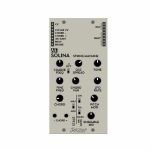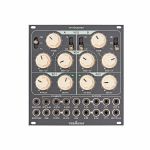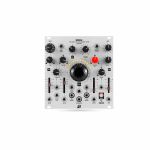100% Compra Segura
Studio equipment
Our full range of studio equipment from all the leading equipment and software brands. Guaranteed fast delivery and low prices.
100% Compra Segura
DJ equipment
Our full range of DJ equipment from all the leading equipment and software brands. Guaranteed fast delivery and low prices. Visit Juno DJ
Filter
Stock
Featured
Price
Synth modules
The Eurorack modular synth format is one of the most exciting areas of music technology. Pioneered by Doepfer, there are now hundreds of brands offering compatible modules of all varieties. You can combine your choice of the best oscillators, filters and much more in order to create a unique, bespoke synth setup which perfectly suits your needs.
Eurorack modules offer the biggest range of options you can imagine, from basic analogue modules which replicate the sound of classic vintage synths, through to digital modules which allow you to explore completely new approaches to making music.
Whether you’re a beginner or a more experienced modular head, you can take your pick of the best modules from leading brands including Mutable Instruments and ALM Busy Circuits.
Our range also includes accessories, cases, patch cables and much more, allowing you to build and customise your perfect modular synth setup.

Artículos del 1 al 32 de 32 en la página 1 de 1
2hp Pluck Physical Modelling Synth Voice Module (silver) (digital/oscillator/synth voice synth module)
Cat: 684048 Rel: 28 Mar 18
Karplus-Strong based physical modelling synth module - 2HP
Notes: Pluck is a physical modelling synth voice. It uses the Karplus-Strong algorithm to create plucked string sounds. The dampening control sets the size of the string and allows for dramatic timbral shifts.
The decay control changes note length from percussive transients to infinite harp sounds. In addition, four voice polyphony provides complex layered tones; all from a single sound source.
Strum a new chord with Pluck.
… Read moreThe decay control changes note length from percussive transients to infinite harp sounds. In addition, four voice polyphony provides complex layered tones; all from a single sound source.
Strum a new chord with Pluck.
2 in stock $113.85
Click for better price!
or call +44 20 7424 1960
quote 684048
quote 684048
2hp Pluck Physical Modelling Synthesiser Voice Module (black) (digital/oscillator/synth voice synth module)
Cat: 714254 Rel: 17 Dec 18
Compact physical modelling synth module featuring Karplus-Strong based algorithms - 2HP
Notes: Pluck is a physical modelling synth voice. It uses the Karplus-Strong algorithm to create plucked string sounds. The dampening control sets the size of the string and allows for dramatic timbral shifts.
The decay control changes note length from percussive transients to infinite harp sounds. In addition, four voice polyphony provides complex layered tones; all from a single sound source.
Strum a new chord with Pluck.
… Read moreThe decay control changes note length from percussive transients to infinite harp sounds. In addition, four voice polyphony provides complex layered tones; all from a single sound source.
Strum a new chord with Pluck.
1 in stock $141.28
Click for better price!
or call +44 20 7424 1960
quote 714254
quote 714254
4ms Stereo Triggered Sampler Recorder & Playback Module (sampling/digital/dual/stereo/oscillator/synth voice synth module)
Cat: 655465 Rel: 29 Aug 17
High fidelity, two-channel stereo sample recorder & playback module
Notes: The Stereo Triggered Sampler can record high quality stereo files, while simultaneously playing two different stereo files. A maximum of 600 samples can be loaded from the removable/swappable microSD card, in a variety of formats up to 96kHz/32-bit/stereo WAV. All sample parameters (1V/oct pitch, sample file selection, length, and start position) are CV controllable.
600 Samples:
A maximum of 600 samples can be loaded at once, arranged into banks of 10 samples each. Samples and banks can be re-arranged on the fly using the simple on-board Edit features. Newly recorded samples can be instantly played back and re-pitched, reversed, chopped up, etc... the result of which can even be bounced down and re-recorded to as a new sample! Sample files are limited to 4GB each, which is over 6 hours at 44k/16b/stereo.
Two Stereo Playback Channels:
Each playback channel has a knob and CV jack for Sample File selection, as well as a Start Position knob and CV jack for controlling where in the sample playback will begin. The Length knob and CV jack determine how much of the sample is played back: from tiny grains, to percussive hits, to longer loops... or just the entire file. These are powerful tools for re-arranging a sample, joining multiple samples, and creating dynamically re-sized loops within a larger sample. Combined with the Play Trigger jack and the 1V/oct jack, the STS can be two complete multi-timbral pitch-tracked stereo voices!
There's also a Reverse button and jack for backwards playback, and an End Out jack for synchronizing loops, or cascading sample playback with other events.
Looping and Sync:
Looping is easy: just hold the PLAY button down for two seconds to toggle loop or one-shot. The loop timing clock will output from the End Out jack. Or, send a clock into the Play Trig jack to sync the loop to external timing.
Stereo Recording:
Whether you patched 47 modules to create the ultimate percussive blast, or you want to capture your four hour ambient performance, recording high-quality .wav files on the STS is simple. Just hit the REC button or fire a trigger and a new stereo .wav file will be created on the SD card. Do as many takes as you need: the STS never deletes your files. Re-ordering or re-arranging samples into banks is easy, even without a computer.
You can even fill a bank with 10 different variations and immediately use them for playback.
By default the STS records at 44.1kHz/16-bit, with an option for 24-bit (a future update may increase the sample rate to 96kHz)
Easy sample loading:
Using a computer is completely optional with the STS, since samples can be recorded directly to the module and placed into the bank of your choosing. But for users with large existing sample banks, the intuitive automatic bank loading features make dragging and dropping your entire sample library a snap. You never have to rename your files again!
… Read more600 Samples:
A maximum of 600 samples can be loaded at once, arranged into banks of 10 samples each. Samples and banks can be re-arranged on the fly using the simple on-board Edit features. Newly recorded samples can be instantly played back and re-pitched, reversed, chopped up, etc... the result of which can even be bounced down and re-recorded to as a new sample! Sample files are limited to 4GB each, which is over 6 hours at 44k/16b/stereo.
Two Stereo Playback Channels:
Each playback channel has a knob and CV jack for Sample File selection, as well as a Start Position knob and CV jack for controlling where in the sample playback will begin. The Length knob and CV jack determine how much of the sample is played back: from tiny grains, to percussive hits, to longer loops... or just the entire file. These are powerful tools for re-arranging a sample, joining multiple samples, and creating dynamically re-sized loops within a larger sample. Combined with the Play Trigger jack and the 1V/oct jack, the STS can be two complete multi-timbral pitch-tracked stereo voices!
There's also a Reverse button and jack for backwards playback, and an End Out jack for synchronizing loops, or cascading sample playback with other events.
Looping and Sync:
Looping is easy: just hold the PLAY button down for two seconds to toggle loop or one-shot. The loop timing clock will output from the End Out jack. Or, send a clock into the Play Trig jack to sync the loop to external timing.
Stereo Recording:
Whether you patched 47 modules to create the ultimate percussive blast, or you want to capture your four hour ambient performance, recording high-quality .wav files on the STS is simple. Just hit the REC button or fire a trigger and a new stereo .wav file will be created on the SD card. Do as many takes as you need: the STS never deletes your files. Re-ordering or re-arranging samples into banks is easy, even without a computer.
You can even fill a bank with 10 different variations and immediately use them for playback.
By default the STS records at 44.1kHz/16-bit, with an option for 24-bit (a future update may increase the sample rate to 96kHz)
Easy sample loading:
Using a computer is completely optional with the STS, since samples can be recorded directly to the module and placed into the bank of your choosing. But for users with large existing sample banks, the intuitive automatic bank loading features make dragging and dropping your entire sample library a snap. You never have to rename your files again!
2 in stock $328.37
Click for better price!
or call +44 20 7424 1960
quote 655465
quote 655465
4ms SWN Spherical Wavetable Navigator 6-Channel Synthesiser Module (black) (oscillator/digital/LFO/synth voice synth module)
Cat: 648377 Rel: 29 Apr 19
Six-channel synthesiser module - 26HP
Notes: The Spherical Wavetable Navigator (SWN) is a six-channel synthesiser that makes it easy to create slowly morphing drones, polyphonic melodies, evolving sequences, and rich textures.
The SWN features six wavetable oscillators with independent pitch, level, and waveform controls. Six LFOs (Low Frequency Oscillators) can be used as modulation sources and/or envelopes, making it easy to add dynamic motion to your patch. Each channel is a full voice and can be "played" using the top row of buttons, the internal LFOs, or note-change detection on the 1V/oct jacks. The SWN ships with 12 three-dimensional (spherical) wavetables and an easy interface which allows you to record and edit custom wavetables from live audio. Open-source software for Mac, Windows, and Linux called SphereEdit can be freely downloaded and allows you computer to create, edit, and convert .wav files into Spherical wavetables to transfer into the SWN with an audio cable.
New firmware available which adds extra features, visit https://4mscompany.com/p.php?p=820&c=5 for details.
… Read moreThe SWN features six wavetable oscillators with independent pitch, level, and waveform controls. Six LFOs (Low Frequency Oscillators) can be used as modulation sources and/or envelopes, making it easy to add dynamic motion to your patch. Each channel is a full voice and can be "played" using the top row of buttons, the internal LFOs, or note-change detection on the 1V/oct jacks. The SWN ships with 12 three-dimensional (spherical) wavetables and an easy interface which allows you to record and edit custom wavetables from live audio. Open-source software for Mac, Windows, and Linux called SphereEdit can be freely downloaded and allows you computer to create, edit, and convert .wav files into Spherical wavetables to transfer into the SWN with an audio cable.
New firmware available which adds extra features, visit https://4mscompany.com/p.php?p=820&c=5 for details.
1 in stock $558.97
Click for better price!
or call +44 20 7424 1960
quote 648377
quote 648377
After Later Audio Atom Modal Synthesiser Module (digital/synth voice module)
Cat: 805274 Rel: 14 Jan 21
Modal synthesiser module - 18HP
Notes: The full power of Mutable Instruments Elements packed into 18hp. It features jack lights that can be turned on/off via a jumper on the back. This module comes loaded with the most recent firmware, with the new Chords mode that unlocks a whole new world of potential.
Based on open source designs by emilie gillet under Creative Commons (CC-BY-SA) license.
Width: 18hp
12V: 130mA
-12V: 10mA
… Read moreBased on open source designs by emilie gillet under Creative Commons (CC-BY-SA) license.
Width: 18hp
12V: 130mA
-12V: 10mA
2 in stock $219.66
Click for better price!
or call +44 20 7424 1960
quote 805274
quote 805274
After Later Audio Pixie Macro Oscillator Module (oscillator/synth voice/digital/drum/LFO/noise synth module)
Cat: 916825 Rel: 16 Dec 22
This is an exact hardware replica of the Mutable Instruments Plaits module.
Notes: This is an exact hardware replica of the Mutable Instruments Plaits module.
Width: 12hp
12V: 50mA
-12V: 5mA
… Read moreWidth: 12hp
12V: 50mA
-12V: 5mA
1 in stock $221.73
Click for better price!
or call +44 20 7424 1960
quote 916825
quote 916825
ALM Akemie's Taiko FM Synthesis Drum Voice Module (drum/synth voice synth module)
Cat: 628650 Rel: 17 Oct 16
Complete drum voice featuring algorithm selection, operator release envelopes, ratios, waveforms & feedback
Notes: Gritty drum voice module based on new old stock Yamaha FM synthesis chips, also capable of a decent range of synth tones. User-friendly knobby interface with a decent range of CV inputs for modulation.
Supplier's notes:
'Akemie's Taiko' is an authentic complete FM synthesis based drum voice created using original Yamaha IC's. It builds on the same technology used in the mighty Akemie's Castle but in a more complete triggered voice form featuring both signal generation and envelope shaping.
The module provides CV and direct control over a number of FM parameters including algorithm selection, operator release envelopes, ratios, waveforms & feedback. This gives a massive range of unique sounds.
The voice is able to track 1 volt per octave allowing it to be used for melodic lines as well as percussion. Also optional 'frequency ramps' can be enabled for additional audio effects.
The drum voice includes a trigger input as well as accent and choke trigger inputs to add further expressive and rhythmic control.
… Read moreSupplier's notes:
'Akemie's Taiko' is an authentic complete FM synthesis based drum voice created using original Yamaha IC's. It builds on the same technology used in the mighty Akemie's Castle but in a more complete triggered voice form featuring both signal generation and envelope shaping.
The module provides CV and direct control over a number of FM parameters including algorithm selection, operator release envelopes, ratios, waveforms & feedback. This gives a massive range of unique sounds.
The voice is able to track 1 volt per octave allowing it to be used for melodic lines as well as percussion. Also optional 'frequency ramps' can be enabled for additional audio effects.
The drum voice includes a trigger input as well as accent and choke trigger inputs to add further expressive and rhythmic control.
4 in stock $287.73
Black Corporation Deckard's Voice Semi-Modular Synth Module (oscillator/VCA/envelope generator/noise/synth voice/filter module)
Cat: 743310 Rel: 24 Feb 21
Semi-modular synth module - 32HP
Notes: Deckard's Voice is an entry level semi-modular synth from Black Corporation for eurorack systems. Sharing the same paradigm and circuit as it's bigger brother Deckard's Dream, trimmed down for eurorack and supplemented with the flexibility available only in a modular format.
Features:
VCO with pulse, glitch saw and sine outputs
Dedicated LFO for PWM
Noise source
External audio input to a filter
Discrete hipass and lowpass filters with resonance and IL-AL-ADR envelope
LFO with sine, saw, ramp, square, smooth and stepped random output
Output VCA with ADSR envelope and velocity control over volume
ADSR (0-10V) and LFO (-5V/+5V) outputs
Master and line level outputs
32HP size
+12/-12V standard eurorack power
38mm deep
… Read moreFeatures:
VCO with pulse, glitch saw and sine outputs
Dedicated LFO for PWM
Noise source
External audio input to a filter
Discrete hipass and lowpass filters with resonance and IL-AL-ADR envelope
LFO with sine, saw, ramp, square, smooth and stepped random output
Output VCA with ADSR envelope and velocity control over volume
ADSR (0-10V) and LFO (-5V/+5V) outputs
Master and line level outputs
32HP size
+12/-12V standard eurorack power
38mm deep
! low stock $708.51
Blue Lantern Modules CSR-VCO CMOS Shift Register VCO Module (synth voice synth module)
Cat: 920883 Rel: 23 Jan 23
CMOS shift register VCO module in 8HP.
Notes: This is a complete mini synthesizer that only requires CV and Gate from your midi to CV converter. You can use an AKAI Mini Keyboard or Arturia KeyStep for example. As long as the product has CV and GATE outputs, you can musically control the CSVCO module. This is a great first-time module, or a great percussive voice to add to your electronic singer section.
The CSVCO is similar to the 'toy' algorithm on the mutable braids module, and the weird noise ring (kinda).
-When the Shift Register is put into random mode using the toggle switches you can create the classic arcade noise sound found on the Atari, and defender arcade game.
-The shift register can loop into more musical overtones, using the toggle switches, that also resemble early Atari pulse wave sounds.
These are the only two modules that BLM were able to confirm use the same related approach of using many pulse harmonics to sculpt the sound. There is no firmware, or simulation happening on the CSVCO. The module is an analogue and CMOS logic hybrid module. There are many modular sections involved to make this happen. It would take many modules to attempt to make your own CSVCO patch on your modular.
You would need the following: Triangle VCO, x2 clock generator, Shift Register module, High Pass Filter, VCA, Envelope Generator, Sub Division Pulse Generator Module, Logic xor, Logic AND, Logic Invert modules, and a mixer module. This would easily take up 64-84hp. Such a complicated patch on your system would probably not work as good as the CSVCO.
It can also be used for bright percussive sounds. All of this tracks +5 octaves, musically.
The CSVCO contains so many over tones (mathematically sub divided), that it is indeed producing chords. The EXT trigger input 'rolls the wheel of chance', and changes the overall tone of the shift register.
The CSVCO seems to sound more 'Minor' at times, it gives out a more creepy, spooky set of chords upon changing up the shift register.
Width: 8hp
Current: +150mA, -140mA
… Read moreThe CSVCO is similar to the 'toy' algorithm on the mutable braids module, and the weird noise ring (kinda).
-When the Shift Register is put into random mode using the toggle switches you can create the classic arcade noise sound found on the Atari, and defender arcade game.
-The shift register can loop into more musical overtones, using the toggle switches, that also resemble early Atari pulse wave sounds.
These are the only two modules that BLM were able to confirm use the same related approach of using many pulse harmonics to sculpt the sound. There is no firmware, or simulation happening on the CSVCO. The module is an analogue and CMOS logic hybrid module. There are many modular sections involved to make this happen. It would take many modules to attempt to make your own CSVCO patch on your modular.
You would need the following: Triangle VCO, x2 clock generator, Shift Register module, High Pass Filter, VCA, Envelope Generator, Sub Division Pulse Generator Module, Logic xor, Logic AND, Logic Invert modules, and a mixer module. This would easily take up 64-84hp. Such a complicated patch on your system would probably not work as good as the CSVCO.
It can also be used for bright percussive sounds. All of this tracks +5 octaves, musically.
The CSVCO contains so many over tones (mathematically sub divided), that it is indeed producing chords. The EXT trigger input 'rolls the wheel of chance', and changes the overall tone of the shift register.
The CSVCO seems to sound more 'Minor' at times, it gives out a more creepy, spooky set of chords upon changing up the shift register.
Width: 8hp
Current: +150mA, -140mA
2 in stock $141.90
Click for better price!
or call +44 20 7424 1960
quote 920883
quote 920883
Doepfer A-111-5 Mini Synthesiser Voice Module (silver) (envelope generator/filter/LFO/oscillator/VCA/synth voice synth module)
Cat: 785445 Rel: 10 Sep 20
A complete monophonic synthesiser module (modular version of Dark Energy).
Notes: A fully modular, Eurorack-format version of the excellent Dark Energy synth, the A-111-5 offers VCO, VCF, LFOs, VCA and envelope generator in a compact format. Brilliant value for a starter system.
Supplier's Notes:
Module A-111-5 is a complete monophonic synthesizer module that includes these components (modular version of Dark Energy):
VCO
Manual tune control (with an internal jumper the range can be set to ~ +/-1 half an octave or ~ +/-2.5 octaves)
Range switch -1 / 0 / +1 octave
Frequency range about 10Hz ... 12kHz - FM (frequency modulation) control with modulation source switch (LFO1 / off / ADSR)
Manual pulsewidth control for rectangle waveform
PWM control with modulation source switch (LFO2 / off / ADSR)
Waveform switch (sawtooth / off / triangle)
The sum of the waveform chosen by this switch and the rectangle is fed into the VCF (to turn the rectangle off the PW control has to be set fully CCW)
External CV input for VCO frequency (1V/octave)
External CV input for external PWM of the rectangle - internal CV input for frequency (1V/octave) connected to the A-100 bus via jumper, the jumper can be used to interrupt this internal connection if not wanted
VCF
24 dB low pass
~ 12 octaves frequency range
Manual frequency control
Tracking switch half - off - full (internally connected to the external frequency CV input of the VCO, i.e. the VCF tracks to the VCO if the switch is set to "half" or "full" position)
XM: exponential FM (frequency modulation) control with modulation source switch (LFO2 / off / ADSR)
LM: linear FM (frequency modulation) control to modulate the VCF by the triangle of the VCO in a linear (!) manner
Manual resonance control (up to self oscillation)
External audio input (this signal is added to the VCO signal)
External CV input for filter frequency - 1V/octave tracking for usage of the VCF as a sine wave oscillator (not as precise as the VCO but much better than most of the other filters)
VCA
Manual amplitude control
AM (amplitude modulation) control with modulation source switch (LFO1 / off / ADSR)
External CV input for VCA amplitude - special control scale: exponential scale in the range from about -20dB to -80/90dB, linear scale from about -20dB to 0dB (Remark: this special control scale results in a loudness behaviour that is a bit different from pure linear or exponential VCA)
LFO1 and LFO2
Manual frequency control
Waveform switch (triangle / off / rectangle)
Range switch (low, audio, medium) - LED display (dual green/red color for positive/negative share of the signal)
The inverted LFO1 signal is available as an additional socket (to use the LFO1 signal for external modules)
An internal jumper can be used to select between the LFO1 signal or the inverted LFO1 signal
ADSR
Manual controls for Attack, Decay, Sustain, Release
Range switch (long, short, medium) - blue LED display
ADSR signal is available as an additional socket (to use the ADSR signal for external modules)
Gate input connected to the A-100 bus via jumper, the jumper can be used to interrupt this internal connection if not wanted
Remarks:
As the LFO frequencies can go up to moderate audio range (~ 5kHz) even audio FM effects of VCO (pitch and pulsewidth), VCF and ADSR are possible.
If the VCO is turned off (waveform switch = center position, pulsewidth control = fully CCW) and the VCF resonance is set to maximum the module can be used as a sine oscillator. The sine can be modulated in a linear manner from the triangle wave of the VCO and by LFO2 in an exponential manner at the same time !
From the factory the socket labelled "LFO1" outputs the inverted LFO1 signal. But as the module has several internal pin headers available even another signal may appear at this socket by changing the internal module patch. These six pin headers are available: LFO1 output, LFO2 output, ADSR output, inverter input, inverter output, output socket. The internal default patch is LFO1 -> inverter input, inverter output -> output socket (i.e. socket = inverted LFO1). But even another signal can be patched to this socket (e.g. inverted ADSR, non-inverted LFO1, inverted or non-inverted LFO2). It is also possible to add a blind panel next to the A-111-5 with a couple of sockets that are connected to the corresponding pins of the A-111-5 pc board. The in- and outputs of the VCO, VCF and VCA are not available as pin headers because the VCO, VCF and VCA are internally connected in the circuit which is used in this module.
… Read moreSupplier's Notes:
Module A-111-5 is a complete monophonic synthesizer module that includes these components (modular version of Dark Energy):
VCO
Manual tune control (with an internal jumper the range can be set to ~ +/-1 half an octave or ~ +/-2.5 octaves)
Range switch -1 / 0 / +1 octave
Frequency range about 10Hz ... 12kHz - FM (frequency modulation) control with modulation source switch (LFO1 / off / ADSR)
Manual pulsewidth control for rectangle waveform
PWM control with modulation source switch (LFO2 / off / ADSR)
Waveform switch (sawtooth / off / triangle)
The sum of the waveform chosen by this switch and the rectangle is fed into the VCF (to turn the rectangle off the PW control has to be set fully CCW)
External CV input for VCO frequency (1V/octave)
External CV input for external PWM of the rectangle - internal CV input for frequency (1V/octave) connected to the A-100 bus via jumper, the jumper can be used to interrupt this internal connection if not wanted
VCF
24 dB low pass
~ 12 octaves frequency range
Manual frequency control
Tracking switch half - off - full (internally connected to the external frequency CV input of the VCO, i.e. the VCF tracks to the VCO if the switch is set to "half" or "full" position)
XM: exponential FM (frequency modulation) control with modulation source switch (LFO2 / off / ADSR)
LM: linear FM (frequency modulation) control to modulate the VCF by the triangle of the VCO in a linear (!) manner
Manual resonance control (up to self oscillation)
External audio input (this signal is added to the VCO signal)
External CV input for filter frequency - 1V/octave tracking for usage of the VCF as a sine wave oscillator (not as precise as the VCO but much better than most of the other filters)
VCA
Manual amplitude control
AM (amplitude modulation) control with modulation source switch (LFO1 / off / ADSR)
External CV input for VCA amplitude - special control scale: exponential scale in the range from about -20dB to -80/90dB, linear scale from about -20dB to 0dB (Remark: this special control scale results in a loudness behaviour that is a bit different from pure linear or exponential VCA)
LFO1 and LFO2
Manual frequency control
Waveform switch (triangle / off / rectangle)
Range switch (low, audio, medium) - LED display (dual green/red color for positive/negative share of the signal)
The inverted LFO1 signal is available as an additional socket (to use the LFO1 signal for external modules)
An internal jumper can be used to select between the LFO1 signal or the inverted LFO1 signal
ADSR
Manual controls for Attack, Decay, Sustain, Release
Range switch (long, short, medium) - blue LED display
ADSR signal is available as an additional socket (to use the ADSR signal for external modules)
Gate input connected to the A-100 bus via jumper, the jumper can be used to interrupt this internal connection if not wanted
Remarks:
As the LFO frequencies can go up to moderate audio range (~ 5kHz) even audio FM effects of VCO (pitch and pulsewidth), VCF and ADSR are possible.
If the VCO is turned off (waveform switch = center position, pulsewidth control = fully CCW) and the VCF resonance is set to maximum the module can be used as a sine oscillator. The sine can be modulated in a linear manner from the triangle wave of the VCO and by LFO2 in an exponential manner at the same time !
From the factory the socket labelled "LFO1" outputs the inverted LFO1 signal. But as the module has several internal pin headers available even another signal may appear at this socket by changing the internal module patch. These six pin headers are available: LFO1 output, LFO2 output, ADSR output, inverter input, inverter output, output socket. The internal default patch is LFO1 -> inverter input, inverter output -> output socket (i.e. socket = inverted LFO1). But even another signal can be patched to this socket (e.g. inverted ADSR, non-inverted LFO1, inverted or non-inverted LFO2). It is also possible to add a blind panel next to the A-111-5 with a couple of sockets that are connected to the corresponding pins of the A-111-5 pc board. The in- and outputs of the VCO, VCF and VCA are not available as pin headers because the VCO, VCF and VCA are internally connected in the circuit which is used in this module.
1 in stock $276.39
Doepfer A-111-6 Miniature Synthesiser Voice Slim Line Series Module (silver) (synth voice synth module)
Cat: 731937 Rel: 15 Nov 19
Complete miniature monophonic synthesiser module - 10HP
Notes: VCO:
- Tune: manual tune control (with an internal jumper the range can be set to ~ +/-1 half an octave or ~ +/-2.5 octaves)
- Oct: range switch -1 / 0 / +1 octave
- Mod: modulation depth (attenuator wired to the Mod. socket)
- Dest: switch that is used to address the modulation to frequency modulation (position FM) or pulsewidth modulation (positon PM), in centre positon no modulation
- PW: manual pulsewidth control for rectangle waveform, PW can be also modulated by the Mod. input as mentioned above
- Wave: waveform switch (sawtooth / off / triangle), the sum of the waveform chosen by this switch and the rectangle is fed into the VCF (to turn the rectangle off the PW control has to be set fully CCW or fully CW)
- 1V/Oct. (socket): external CV input for VCO frequency (1V/octave)
- Access to internal bus CV (via jumper, optional, please remove the bus jumper if this feature is not used to avoid unwanted frequency modulation as then the unused CV line of the bus works as a kind of antenna)
- Triangle core VCO, frequency range about 32Hz ... 8kHz
Balance unit:
- The balance unit is made of two VCAs which are controlled by the sum of manual Balance control and the balance CV input in the opposite direction.
- The audio input of VCA1 is hard-wired to the VCO output, audio input 2 is connected to the socket Ext.In.
- The output of the balance unit is used as audio input for the VCF
- Bal.: manual balance control, fully CCW the internal VCO is used, fully CW the external signal (Ext.In) is used, at centre position both signals have about the same level
- CV Bal.: CV input for balance (range about 0...+5V)
- Ext. In: external audio input for VCA2, about 5 Vpp level required for similar loudness as the internal VCO
- This socket is normalled to the internal VCO suboctave f/2 signal (rectangle with half the frequency), if no external signal is applied the suboctave signal is used as the second signal for the balance unit
VCF:
- 24 dB low pass
- Frq: manual frequency control
- FM1: frequency modulation depth (attenuator wired to the VCF FM1 socket, the socket is normalled to the internal Envelope signal and then FM1 controls the modulation depth of the internal envelope applied to the filter)
- FM2 (socket) : second CV input for VCF without attenuator (about 1V/octave), can be used e.g. for VCF tracking by connecting the same CV which is used also for the VCO frequency
- Res: manual resonance control (up to self oscillation)
- If the VCO is turned off (waveform switch = centre position, pulsewidth control = fully CCW or CW) and the VCF resonance is set to maximum the module can be used as a sine oscillator, the tracking at socket VCF FM2 is about 1V/octave (not as precise as the VCO but much better than most other filters)
- ~ 11 octaves frequency range (~ 10 Hz ... 20kHz)
VCA:
- Gain: manual amplitude control (initial gain), can be used to open the VCA without envelope signal
- VCA (switch): used to switch between gate and envelope as control signal for the VCA, in centre position the VCA is not controlled by envelope or gate
- Note: when gate is used the VCA is controlled directly by the gate signal (i.e. hard on/off), this may lead to clicking noise under certain conditions (especially with low VCO/VCF frequencies)
- Special control scale: exponential scale in the range from about -20dB to -80/90dB, linear scale from about -20dB to 0dB
- Remark: this special control scale results in a loudness behaviour that is a bit different from pure linear or exponential VCAs
- Out: audio output of the module (= VCA output)
Envelope:
- Gate (socket): Gate input (min. +5V), can be normalled to the bus gate signal by means of a jumper
- Att: manual control for Attack
- D/R: manual control for Decay/Release
- Env. (switch): used to switch between A/D, ADSR and A/R mode of the envelope generator, in centre position (ADSR) the sustain level is fixed to about 50%
- Envelope (socket): envelope output (about +10V)
- CVT (socket): CV input for time control, by means of two internal jumpers one can select which time parameters are controlled by the CVT input (e.g. A only or D/R only or A/D/R) and in which direction (i.e. if an increasing CVT shortens or stretches the time parameter in question)
- Envelope LED display
- Attack time range: ~ 1ms ... 5 sec (can be extended by using the CVT input)
- Decay/Release time range: ~ 1ms ... 15 sec (can be extended by using the CVT input)
… Read more- Tune: manual tune control (with an internal jumper the range can be set to ~ +/-1 half an octave or ~ +/-2.5 octaves)
- Oct: range switch -1 / 0 / +1 octave
- Mod: modulation depth (attenuator wired to the Mod. socket)
- Dest: switch that is used to address the modulation to frequency modulation (position FM) or pulsewidth modulation (positon PM), in centre positon no modulation
- PW: manual pulsewidth control for rectangle waveform, PW can be also modulated by the Mod. input as mentioned above
- Wave: waveform switch (sawtooth / off / triangle), the sum of the waveform chosen by this switch and the rectangle is fed into the VCF (to turn the rectangle off the PW control has to be set fully CCW or fully CW)
- 1V/Oct. (socket): external CV input for VCO frequency (1V/octave)
- Access to internal bus CV (via jumper, optional, please remove the bus jumper if this feature is not used to avoid unwanted frequency modulation as then the unused CV line of the bus works as a kind of antenna)
- Triangle core VCO, frequency range about 32Hz ... 8kHz
Balance unit:
- The balance unit is made of two VCAs which are controlled by the sum of manual Balance control and the balance CV input in the opposite direction.
- The audio input of VCA1 is hard-wired to the VCO output, audio input 2 is connected to the socket Ext.In.
- The output of the balance unit is used as audio input for the VCF
- Bal.: manual balance control, fully CCW the internal VCO is used, fully CW the external signal (Ext.In) is used, at centre position both signals have about the same level
- CV Bal.: CV input for balance (range about 0...+5V)
- Ext. In: external audio input for VCA2, about 5 Vpp level required for similar loudness as the internal VCO
- This socket is normalled to the internal VCO suboctave f/2 signal (rectangle with half the frequency), if no external signal is applied the suboctave signal is used as the second signal for the balance unit
VCF:
- 24 dB low pass
- Frq: manual frequency control
- FM1: frequency modulation depth (attenuator wired to the VCF FM1 socket, the socket is normalled to the internal Envelope signal and then FM1 controls the modulation depth of the internal envelope applied to the filter)
- FM2 (socket) : second CV input for VCF without attenuator (about 1V/octave), can be used e.g. for VCF tracking by connecting the same CV which is used also for the VCO frequency
- Res: manual resonance control (up to self oscillation)
- If the VCO is turned off (waveform switch = centre position, pulsewidth control = fully CCW or CW) and the VCF resonance is set to maximum the module can be used as a sine oscillator, the tracking at socket VCF FM2 is about 1V/octave (not as precise as the VCO but much better than most other filters)
- ~ 11 octaves frequency range (~ 10 Hz ... 20kHz)
VCA:
- Gain: manual amplitude control (initial gain), can be used to open the VCA without envelope signal
- VCA (switch): used to switch between gate and envelope as control signal for the VCA, in centre position the VCA is not controlled by envelope or gate
- Note: when gate is used the VCA is controlled directly by the gate signal (i.e. hard on/off), this may lead to clicking noise under certain conditions (especially with low VCO/VCF frequencies)
- Special control scale: exponential scale in the range from about -20dB to -80/90dB, linear scale from about -20dB to 0dB
- Remark: this special control scale results in a loudness behaviour that is a bit different from pure linear or exponential VCAs
- Out: audio output of the module (= VCA output)
Envelope:
- Gate (socket): Gate input (min. +5V), can be normalled to the bus gate signal by means of a jumper
- Att: manual control for Attack
- D/R: manual control for Decay/Release
- Env. (switch): used to switch between A/D, ADSR and A/R mode of the envelope generator, in centre position (ADSR) the sustain level is fixed to about 50%
- Envelope (socket): envelope output (about +10V)
- CVT (socket): CV input for time control, by means of two internal jumpers one can select which time parameters are controlled by the CVT input (e.g. A only or D/R only or A/D/R) and in which direction (i.e. if an increasing CVT shortens or stretches the time parameter in question)
- Envelope LED display
- Attack time range: ~ 1ms ... 5 sec (can be extended by using the CVT input)
- Decay/Release time range: ~ 1ms ... 15 sec (can be extended by using the CVT input)
1 in stock $173.25
Doepfer A-111-6v Miniature Synthesiser Voice Vintage Edition Module (black) (synth voice synth module)
Cat: 749811 Rel: 15 Nov 19
Complete miniature monophonic synthesiser module - 10HP
Notes: VCO:
- Tune: manual tune control (with an internal jumper the range can be set to ~ +/-1 half an octave or ~ +/-2.5 octaves)
- Oct: range switch -1 / 0 / +1 octave
- Mod: modulation depth (attenuator wired to the Mod. socket)
- Dest: switch that is used to address the modulation to frequency modulation (position FM) or pulsewidth modulation (positon PM), in centre positon no modulation
- PW: manual pulsewidth control for rectangle waveform, PW can be also modulated by the Mod. input as mentioned above
- Wave: waveform switch (sawtooth / off / triangle), the sum of the waveform chosen by this switch and the rectangle is fed into the VCF (to turn the rectangle off the PW control has to be set fully CCW or fully CW)
- 1V/Oct. (socket): external CV input for VCO frequency (1V/octave)
- Access to internal bus CV (via jumper, optional, please remove the bus jumper if this feature is not used to avoid unwanted frequency modulation as then the unused CV line of the bus works as a kind of antenna)
- Triangle core VCO, frequency range about 32Hz ... 8kHz
Balance unit:
- The balance unit is made of two VCAs which are controlled by the sum of manual Balance control and the balance CV input in the opposite direction.
- The audio input of VCA1 is hard-wired to the VCO output, audio input 2 is connected to the socket Ext.In.
- The output of the balance unit is used as audio input for the VCF
- Bal.: manual balance control, fully CCW the internal VCO is used, fully CW the external signal (Ext.In) is used, at centre position both signals have about the same level
- CV Bal.: CV input for balance (range about 0...+5V)
- Ext. In: external audio input for VCA2, about 5 Vpp level required for similar loudness as the internal VCO
- This socket is normalled to the internal VCO suboctave f/2 signal (rectangle with half the frequency), if no external signal is applied the suboctave signal is used as the second signal for the balance unit
VCF:
- 24 dB low pass
- Frq: manual frequency control
- FM1: frequency modulation depth (attenuator wired to the VCF FM1 socket, the socket is normalled to the internal Envelope signal and then FM1 controls the modulation depth of the internal envelope applied to the filter)
- FM2 (socket) : second CV input for VCF without attenuator (about 1V/octave), can be used e.g. for VCF tracking by connecting the same CV which is used also for the VCO frequency
- Res: manual resonance control (up to self oscillation)
- If the VCO is turned off (waveform switch = centre position, pulsewidth control = fully CCW or CW) and the VCF resonance is set to maximum the module can be used as a sine oscillator, the tracking at socket VCF FM2 is about 1V/octave (not as precise as the VCO but much better than most other filters)
- ~ 11 octaves frequency range (~ 10 Hz ... 20kHz)
VCA:
- Gain: manual amplitude control (initial gain), can be used to open the VCA without envelope signal
- VCA (switch): used to switch between gate and envelope as control signal for the VCA, in centre position the VCA is not controlled by envelope or gate
- Note: when gate is used the VCA is controlled directly by the gate signal (i.e. hard on/off), this may lead to clicking noise under certain conditions (especially with low VCO/VCF frequencies)
- Special control scale: exponential scale in the range from about -20dB to -80/90dB, linear scale from about -20dB to 0dB
- Remark: this special control scale results in a loudness behaviour that is a bit different from pure linear or exponential VCAs
- Out: audio output of the module (= VCA output)
Envelope:
- Gate (socket): Gate input (min. +5V), can be normalled to the bus gate signal by means of a jumper
- Att: manual control for Attack
- D/R: manual control for Decay/Release
- Env. (switch): used to switch between A/D, ADSR and A/R mode of the envelope generator, in centre position (ADSR) the sustain level is fixed to about 50%
- Envelope (socket): envelope output (about +10V)
- CVT (socket): CV input for time control, by means of two internal jumpers one can select which time parameters are controlled by the CVT input (e.g. A only or D/R only or A/D/R) and in which direction (i.e. if an increasing CVT shortens or stretches the time parameter in question)
- Envelope LED display
- Attack time range: ~ 1ms ... 5 sec (can be extended by using the CVT input)
- Decay/Release time range: ~ 1ms ... 15 sec (can be extended by using the CVT input)
… Read more- Tune: manual tune control (with an internal jumper the range can be set to ~ +/-1 half an octave or ~ +/-2.5 octaves)
- Oct: range switch -1 / 0 / +1 octave
- Mod: modulation depth (attenuator wired to the Mod. socket)
- Dest: switch that is used to address the modulation to frequency modulation (position FM) or pulsewidth modulation (positon PM), in centre positon no modulation
- PW: manual pulsewidth control for rectangle waveform, PW can be also modulated by the Mod. input as mentioned above
- Wave: waveform switch (sawtooth / off / triangle), the sum of the waveform chosen by this switch and the rectangle is fed into the VCF (to turn the rectangle off the PW control has to be set fully CCW or fully CW)
- 1V/Oct. (socket): external CV input for VCO frequency (1V/octave)
- Access to internal bus CV (via jumper, optional, please remove the bus jumper if this feature is not used to avoid unwanted frequency modulation as then the unused CV line of the bus works as a kind of antenna)
- Triangle core VCO, frequency range about 32Hz ... 8kHz
Balance unit:
- The balance unit is made of two VCAs which are controlled by the sum of manual Balance control and the balance CV input in the opposite direction.
- The audio input of VCA1 is hard-wired to the VCO output, audio input 2 is connected to the socket Ext.In.
- The output of the balance unit is used as audio input for the VCF
- Bal.: manual balance control, fully CCW the internal VCO is used, fully CW the external signal (Ext.In) is used, at centre position both signals have about the same level
- CV Bal.: CV input for balance (range about 0...+5V)
- Ext. In: external audio input for VCA2, about 5 Vpp level required for similar loudness as the internal VCO
- This socket is normalled to the internal VCO suboctave f/2 signal (rectangle with half the frequency), if no external signal is applied the suboctave signal is used as the second signal for the balance unit
VCF:
- 24 dB low pass
- Frq: manual frequency control
- FM1: frequency modulation depth (attenuator wired to the VCF FM1 socket, the socket is normalled to the internal Envelope signal and then FM1 controls the modulation depth of the internal envelope applied to the filter)
- FM2 (socket) : second CV input for VCF without attenuator (about 1V/octave), can be used e.g. for VCF tracking by connecting the same CV which is used also for the VCO frequency
- Res: manual resonance control (up to self oscillation)
- If the VCO is turned off (waveform switch = centre position, pulsewidth control = fully CCW or CW) and the VCF resonance is set to maximum the module can be used as a sine oscillator, the tracking at socket VCF FM2 is about 1V/octave (not as precise as the VCO but much better than most other filters)
- ~ 11 octaves frequency range (~ 10 Hz ... 20kHz)
VCA:
- Gain: manual amplitude control (initial gain), can be used to open the VCA without envelope signal
- VCA (switch): used to switch between gate and envelope as control signal for the VCA, in centre position the VCA is not controlled by envelope or gate
- Note: when gate is used the VCA is controlled directly by the gate signal (i.e. hard on/off), this may lead to clicking noise under certain conditions (especially with low VCO/VCF frequencies)
- Special control scale: exponential scale in the range from about -20dB to -80/90dB, linear scale from about -20dB to 0dB
- Remark: this special control scale results in a loudness behaviour that is a bit different from pure linear or exponential VCAs
- Out: audio output of the module (= VCA output)
Envelope:
- Gate (socket): Gate input (min. +5V), can be normalled to the bus gate signal by means of a jumper
- Att: manual control for Attack
- D/R: manual control for Decay/Release
- Env. (switch): used to switch between A/D, ADSR and A/R mode of the envelope generator, in centre position (ADSR) the sustain level is fixed to about 50%
- Envelope (socket): envelope output (about +10V)
- CVT (socket): CV input for time control, by means of two internal jumpers one can select which time parameters are controlled by the CVT input (e.g. A only or D/R only or A/D/R) and in which direction (i.e. if an increasing CVT shortens or stretches the time parameter in question)
- Envelope LED display
- Attack time range: ~ 1ms ... 5 sec (can be extended by using the CVT input)
- Decay/Release time range: ~ 1ms ... 15 sec (can be extended by using the CVT input)
3 in stock $177.39
Dreadbox Telepathy Full Synth Voice Module (MIDI/synth voice module)
Cat: 947127 Rel: 12 Jul 23
Synth voice module - 10HP.
Notes: Simple to look at but deceptively powerful, Dreadbox's Telepathy is a full analogue synth in a small module, featuring VCO, low-pass and high-pass filters, LFO, envelopes and VCA.
Supplier's Notes:
Telepathy is a full voice analogue synthesizer module with deep modulation options due to its multi-destination LFO and Envelope. From Bass to Lead sounds, to drums and drones, Telepathy has broad and versatile sound design capabilities. It has a Full Analogue path (Typhon VCO, 4-pole low pass / 2-pole high pass filters, analogue VCA) that is digitally controlled for more precision over its parameters, resulting in a warm, present and distinct Dreadbox sound.
With lots of useful and musical features integrated into a compact size (10hp), and its skiff friendly design, Telepathy is a great addition to small or large Eurorack systems.
Features:
1x Analogue Oscillator with saw, square, -1 oct square sub and noise, plus PW control for square, level for noise and waveshape
Automatic tuning for the oscillator and fine tune
Analogue 24db Resonant Low pass filter with Oscillator FM and Noise FM and 6db High pass filter
Analogue VCA
1x LFO with Free/Key/Track/BPM/BPM Key modes, Fade in, Triangle/Saw/Ramp/Square/Random waveforms, that is mapped to various parameters
2x Envelopes, one dedicated to the VCA with Velocity control and one loopable for Low pass Filter, Pitch and PW
CV in patch that can be mapped to all the basic parameters in parallel with dedicated amount for each parameter
MIDI in/out+through
CC in/out, Program Change in/out
Multitimbral Chaining functionality via MIDI up to 8 modules 16 presets
10HP
… Read moreSupplier's Notes:
Telepathy is a full voice analogue synthesizer module with deep modulation options due to its multi-destination LFO and Envelope. From Bass to Lead sounds, to drums and drones, Telepathy has broad and versatile sound design capabilities. It has a Full Analogue path (Typhon VCO, 4-pole low pass / 2-pole high pass filters, analogue VCA) that is digitally controlled for more precision over its parameters, resulting in a warm, present and distinct Dreadbox sound.
With lots of useful and musical features integrated into a compact size (10hp), and its skiff friendly design, Telepathy is a great addition to small or large Eurorack systems.
Features:
1x Analogue Oscillator with saw, square, -1 oct square sub and noise, plus PW control for square, level for noise and waveshape
Automatic tuning for the oscillator and fine tune
Analogue 24db Resonant Low pass filter with Oscillator FM and Noise FM and 6db High pass filter
Analogue VCA
1x LFO with Free/Key/Track/BPM/BPM Key modes, Fade in, Triangle/Saw/Ramp/Square/Random waveforms, that is mapped to various parameters
2x Envelopes, one dedicated to the VCA with Velocity control and one loopable for Low pass Filter, Pitch and PW
CV in patch that can be mapped to all the basic parameters in parallel with dedicated amount for each parameter
MIDI in/out+through
CC in/out, Program Change in/out
Multitimbral Chaining functionality via MIDI up to 8 modules 16 presets
10HP
4 in stock $191.26
Endorphin.es Two Of Cups 2-Voice Intuitive Sample Player Module (silver) (digital/dual/stereo/sampling/synth voice synth module)
Cat: 883285 Rel: 14 Jun 22
2 voice intuitive sample player with 8 banks each containing 24 samples
Notes: Two Of Cups - include samples in your live set. Two of them at once with a wide variety of CV-able features. Simply load one of 8 (!) banks each containing up to 24 samples for each of the two voices and off you go (unlock this feature with firmware 1.1!). Needless to say you can change the samples under CV and if needed - you can set up the trigger delay for each voice because that boy plays its sample so instantly and sample accurate with the with lightning speed. Breathe life and fresh sounds into your setup with a small footprint (6 HP) you would normally need to carry around a gazillion of gear to reproduce the sonic capabilities. Alternatively, use it the boring way and simply play drum one-shots off it.
2 voice intuitive sample player each containing 24 samples and organized in 8 banks
Zero-latency sample playback - directly from micro SD card
Factory sound-bank by Julia Bondar
On-board envelope generator decay control, pitch control with 1V/Oct input and sample selection control with meta cv input
Arbitrary sample rate: 8, 16 and 24 bit samples with 12 bit output bitrate
Power consumption:
125 mA +12V
20 mA -12V
0 mA 5V
Dimensions:
6 HP
30 mm deep
… Read more2 voice intuitive sample player each containing 24 samples and organized in 8 banks
Zero-latency sample playback - directly from micro SD card
Factory sound-bank by Julia Bondar
On-board envelope generator decay control, pitch control with 1V/Oct input and sample selection control with meta cv input
Arbitrary sample rate: 8, 16 and 24 bit samples with 12 bit output bitrate
Power consumption:
125 mA +12V
20 mA -12V
0 mA 5V
Dimensions:
6 HP
30 mm deep
1 in stock $176.35
Eowave Quadrantid Swarm Digital Synth Voice Module (reverb/synth voice/digital/oscillator/filter/MIDI/sequencer/LFO module)
Cat: 794135 Rel: 21 Oct 20
Digital synth voice module - 40HP
Notes: Unique synth voice based around a digital triangle wave oscillator with percussive element, dual filters, envelope, LFO, spring reverb and touch pads for performance.
Supplier's Notes:
The Quandrantid Swarm module is a versatile and unique synth voice for sound designers and musicians looking to explore exquisite and unfamiliar timbres that range from subtle to outrageous, nebulous to shimmering.
It features a digital synthesizer voice with a percussive element, an analog 2-pole filter, an LFO with eight waveforms, and a spring reverb. The 8 touch keys can be used as a mono keyboard, polyphonic keyboard or an eight step sequencer. The synth interfaces with other instruments via MIDI, and CV/Trig inputs. The semi-modular design allows you to get hands on immediately, but you can and should use patch cables to fully explore the potential of this instrument.
Power consumption: 170mA at +12 V and 70mA at -12 V
HP : 40
… Read moreSupplier's Notes:
The Quandrantid Swarm module is a versatile and unique synth voice for sound designers and musicians looking to explore exquisite and unfamiliar timbres that range from subtle to outrageous, nebulous to shimmering.
It features a digital synthesizer voice with a percussive element, an analog 2-pole filter, an LFO with eight waveforms, and a spring reverb. The 8 touch keys can be used as a mono keyboard, polyphonic keyboard or an eight step sequencer. The synth interfaces with other instruments via MIDI, and CV/Trig inputs. The semi-modular design allows you to get hands on immediately, but you can and should use patch cables to fully explore the potential of this instrument.
Power consumption: 170mA at +12 V and 70mA at -12 V
HP : 40
3 in stock $475.44
Erica Synths Bassline Analogue Synth Voice Module With Acid Basslines (filter/oscillator/synth voice module)
Cat: 690948 Rel: 19 Sep 18
Synth voice module - 14HP
Notes: Erica Synths Bassline is fully analogue synth voice module for ultimate basslines and leads.
It features AS3340 VCO with three waveforms, a filter inspired by Erica Synths Acidbox and unique features - transistor based suboscillator and two BBD lines that emulate VCO detune creating a sound of massive polysynth from one oscillator.
Accent provides more expression to the bassline, by adding volume and opening the VCF slightly.
… Read moreIt features AS3340 VCO with three waveforms, a filter inspired by Erica Synths Acidbox and unique features - transistor based suboscillator and two BBD lines that emulate VCO detune creating a sound of massive polysynth from one oscillator.
Accent provides more expression to the bassline, by adding volume and opening the VCF slightly.
1 in stock $292.89
Click for better price!
or call +44 20 7424 1960
quote 690948
quote 690948
Erica Synths Pico Voice Synth Voice Module (oscillator/synth voice module)
Cat: 686678 Rel: 30 Apr 18
Synth voice module with 8 sound generation algorithms - 3HP
Notes: Erica Pico Voice is amazingly versatile sound source in just 3HP. It features 8 sound generation algorithms: Karplus Strong, Chords, Wavetable, TB303 bassline emulation, PWM, Supersaw, Wavefold and Harmonic saturation, with three adjustable parameters per algorithm and CV control over one user defined parameter. Despite the small size, Pico Voice sounds bigger than it is!
Dimensions
3 HP
35 mm deep
Current Draw
30 mA +12V
20 mA -12V
… Read moreDimensions
3 HP
35 mm deep
Current Draw
30 mA +12V
20 mA -12V
1 in stock $126.84
Click for better price!
or call +44 20 7424 1960
quote 686678
quote 686678
Flame Fire 8-Voice Percussion Synthesiser Module (drum/synth voice module)
Cat: 950801 Rel: 07 Sep 23
Full 8-way polyphonic drum and percussion synthesiser module - 22HP.
Notes: Up to eight voices of digitally synthesised drums, percussion and synth sounds from this versatile module, featuring virtual analogue models as well as FM and wavetable options.
Supplier's Notes:
Flame "Fire" percussion synth module
The module is a full 8-way polyphonic drum and percussion synthesizer. It offers different digital synthesis algorithms, which can be distributed over 8 channels. The sound engine delivers virtual analog sounds as well as different digital percussion sounds, which are generated with FM, wavetable or virtual analog synthesis. It is also possible to create sim- ple monophonic bass or synthesizer voices.
During development, particular attention was paid to direct and simple usability with regard to live operation. The hardware essentially consists of two parts (which are deli- vered together). On the one hand there is the basic module with all controls, the display, connections for MIDI, 2x CV inputs and 5 audio outputs.
There is also a separate XFIRE I/O extension with sockets for the 16 analog trigger/gate/CV inputs and 3 additional audio outputs. Both modules are connected via a 60cm long ribbon cable. In this way, the XFIRE module can be installed anywhere else in the rack. The base module is therefore only 22TE wide and can also work alone without the extension as a MIDI expander.
A maximum of 8 audio outputs are available. A stereo pair (outputs 7+8), plus 6 additio- nal individual direct outputs. All outputs are freely configurable. Two pages with settings for panorama and volume are available for the stereo main out.
There is a gate/trigger input and a configurable CV input for each channel. Two additio- nal programmable CV inputs can be used for further controls. Regardless of the analog connection, the module offers full MIDI functionality. Two MIDI inputs and a MIDI output/softthru allow integration into an external MIDI setup. The firmware can be upda- ted via MIDI Sysex. The created KIT data can also be saved or exchanged.
… Read moreSupplier's Notes:
Flame "Fire" percussion synth module
The module is a full 8-way polyphonic drum and percussion synthesizer. It offers different digital synthesis algorithms, which can be distributed over 8 channels. The sound engine delivers virtual analog sounds as well as different digital percussion sounds, which are generated with FM, wavetable or virtual analog synthesis. It is also possible to create sim- ple monophonic bass or synthesizer voices.
During development, particular attention was paid to direct and simple usability with regard to live operation. The hardware essentially consists of two parts (which are deli- vered together). On the one hand there is the basic module with all controls, the display, connections for MIDI, 2x CV inputs and 5 audio outputs.
There is also a separate XFIRE I/O extension with sockets for the 16 analog trigger/gate/CV inputs and 3 additional audio outputs. Both modules are connected via a 60cm long ribbon cable. In this way, the XFIRE module can be installed anywhere else in the rack. The base module is therefore only 22TE wide and can also work alone without the extension as a MIDI expander.
A maximum of 8 audio outputs are available. A stereo pair (outputs 7+8), plus 6 additio- nal individual direct outputs. All outputs are freely configurable. Two pages with settings for panorama and volume are available for the stereo main out.
There is a gate/trigger input and a configurable CV input for each channel. Two additio- nal programmable CV inputs can be used for further controls. Regardless of the analog connection, the module offers full MIDI functionality. Two MIDI inputs and a MIDI output/softthru allow integration into an external MIDI setup. The firmware can be upda- ted via MIDI Sysex. The created KIT data can also be saved or exchanged.
1 in stock $442.43
Click for better price!
or call +44 20 7424 1960
quote 950801
quote 950801
Haken Audio EaganMatrix Synth Voice Module (digital/dual/stereo/effect/synth voice/MIDI/oscillator synth module)
Cat: 847880 Rel: 04 May 22
Sound engine for Eurorack that can be controlled by control vlotages and/or MIDI
Notes: A full-on digital modular system in a single module. Eight-voice polyphony, audio processing and CV/MIDI functionality, all customisable via the PC/Mac editor. Serious DSP power in 22 hp.
Supplier's Notes:
Integrate the power of EaganMatrix Sound Technology into your Eurorack! The EaganMatrix Module is a full-featured EaganMatrix Sound Engine for Eurorack, and can be controlled by control voltages and/or Midi. This versatile module can act as a sound source, a sound processor, a CV source (via connection to an external Control Voltage Converter), a Midi source, or a customizable combination of all these capabilities.
The EaganMatrix Module provides a truly versatile framework for both studio and live performance. Flexibility is key, due to its audio inputs and outputs, integrated CV inputs, external CV outputs (via Control Voltage Converter), and robust implementation of MPE and MPE+ Midi.
A single EaganMatrix Preset can give completely different sonic results, depending on how it is patched into a particular Eurorack ecosystem. Hundreds of System Presets are included with the EaganMatrix Module. In addition, an external cross-platform (Mac and PC) Haken Editor may be connected to modify and customize the supplied EaganMatrix System Presets, or create completely new presets from scratch.
The EaganMatrix Sound Technology, originally created for the gesturally highly sensitive Continuum, is now available to you in a Eurorack module. The EaganMatrix Module will quickly become a 'goto' component in your modular sound design and sonic composition.
Haken Audio's EaganMatrix Module offers:
Polyphony: Nominal 1, Maximum 8
Direct CV note control is limited to 1 voice at a time, but higher polyphony avoids voice stealing when EaganMatrix presets have long decays, and higher polyphony is often useful for Midi input.
4 Per-note CV Inputs: W, X, Y, Z
Gate (W) - Triggers at 1V, with max range -10V to +10V
Pitch (X) - 1V per octave, with programmable offset for Middle C; useful input voltages are a subpart of -10V to +10V (depends on the programmable offset selected)
Timbre (Y) - Function depends on EaganMatrix preset; voltage range is normally 0V to 5V, but -5V to +5V can be useful when combined with a programmable offset
Loudness (Z) - normally 0V to 5V, but -5V to +5V can be useful when combined with a programmable offset
4 Global CV Inputs: i, ii, iii, iv
Functionality depends on EaganMatrix preset; these CV affect all voices (notes from WXYZ and Midi); each global CV is normally 0V to 5V, but -5V to +5V can be useful when combined with a programmable offset
2 Analog Audio Inputs: Left and Right, or Mono
2 Analog Audio Outputs: Left and Right, or Mono Sum
-12dB switch selects between Eurorack Level and Line Level
Midi over USB
Allows bidirectional MPE and MPE+ connection to other devices; allows connection to the Haken Editor for editing and archiving EaganMatrix presets (USB-A cable included with purchase)
Universal 3.5mm Midi In (Type A, Type B, and TS)
Allows connection to other Midi devices without need of computer or USB (adapter to 5-pin DIN Midi In included with purchase)
Type B 3.5mm Midi Out
Allows connection to other Midi devices without need of computer or USB (adapter to 5-pin DIN Midi Out included with purchase)
i2c Port for Communication to the Control Voltage Converter
(a switch selects between 3.5mm Midi Out and i2c functionality)
12 Switches, 1 Rotary, and LED Matrix
A menu system allows stand-alone operation without need of computer, and provides monitoring for notes being played and CV input levels
The EaganMatrix is a modular digital synthesizer invented by Edmund Eagan, utilizing a DSP engine designed by Lippold Haken. This is the same EaganMatrix Sound Technology internal to the Continuum Fingerboard, the ContinuuMini, and Expressive E's Osmose keyboard. The EaganMatrix allows the user to finely craft their musical sound by digitally connecting audio and control modules via a patching matrix. The EaganMatrix Module contains a sophisticated digital modular patching world of its own, ready to interact with your other Eurorack modules to make musical results never before possible.
Power and size
The EaganMatrix Module requires +12V, +5V, ground, and -12V from your Eurorack enclosure.
A 16-pin standard Eurorack power cable is included with purchase.
Current requirements: 25mA at +12V and -12V. 300 mA max (190 mA avg) at +5V.
The processing power of the EaganMatrix Module is 2x, same as the ContinuuMini.
The EaganMatrix Module dimensions are 22 HP and 3cm depth.
… Read moreSupplier's Notes:
Integrate the power of EaganMatrix Sound Technology into your Eurorack! The EaganMatrix Module is a full-featured EaganMatrix Sound Engine for Eurorack, and can be controlled by control voltages and/or Midi. This versatile module can act as a sound source, a sound processor, a CV source (via connection to an external Control Voltage Converter), a Midi source, or a customizable combination of all these capabilities.
The EaganMatrix Module provides a truly versatile framework for both studio and live performance. Flexibility is key, due to its audio inputs and outputs, integrated CV inputs, external CV outputs (via Control Voltage Converter), and robust implementation of MPE and MPE+ Midi.
A single EaganMatrix Preset can give completely different sonic results, depending on how it is patched into a particular Eurorack ecosystem. Hundreds of System Presets are included with the EaganMatrix Module. In addition, an external cross-platform (Mac and PC) Haken Editor may be connected to modify and customize the supplied EaganMatrix System Presets, or create completely new presets from scratch.
The EaganMatrix Sound Technology, originally created for the gesturally highly sensitive Continuum, is now available to you in a Eurorack module. The EaganMatrix Module will quickly become a 'goto' component in your modular sound design and sonic composition.
Haken Audio's EaganMatrix Module offers:
Polyphony: Nominal 1, Maximum 8
Direct CV note control is limited to 1 voice at a time, but higher polyphony avoids voice stealing when EaganMatrix presets have long decays, and higher polyphony is often useful for Midi input.
4 Per-note CV Inputs: W, X, Y, Z
Gate (W) - Triggers at 1V, with max range -10V to +10V
Pitch (X) - 1V per octave, with programmable offset for Middle C; useful input voltages are a subpart of -10V to +10V (depends on the programmable offset selected)
Timbre (Y) - Function depends on EaganMatrix preset; voltage range is normally 0V to 5V, but -5V to +5V can be useful when combined with a programmable offset
Loudness (Z) - normally 0V to 5V, but -5V to +5V can be useful when combined with a programmable offset
4 Global CV Inputs: i, ii, iii, iv
Functionality depends on EaganMatrix preset; these CV affect all voices (notes from WXYZ and Midi); each global CV is normally 0V to 5V, but -5V to +5V can be useful when combined with a programmable offset
2 Analog Audio Inputs: Left and Right, or Mono
2 Analog Audio Outputs: Left and Right, or Mono Sum
-12dB switch selects between Eurorack Level and Line Level
Midi over USB
Allows bidirectional MPE and MPE+ connection to other devices; allows connection to the Haken Editor for editing and archiving EaganMatrix presets (USB-A cable included with purchase)
Universal 3.5mm Midi In (Type A, Type B, and TS)
Allows connection to other Midi devices without need of computer or USB (adapter to 5-pin DIN Midi In included with purchase)
Type B 3.5mm Midi Out
Allows connection to other Midi devices without need of computer or USB (adapter to 5-pin DIN Midi Out included with purchase)
i2c Port for Communication to the Control Voltage Converter
(a switch selects between 3.5mm Midi Out and i2c functionality)
12 Switches, 1 Rotary, and LED Matrix
A menu system allows stand-alone operation without need of computer, and provides monitoring for notes being played and CV input levels
The EaganMatrix is a modular digital synthesizer invented by Edmund Eagan, utilizing a DSP engine designed by Lippold Haken. This is the same EaganMatrix Sound Technology internal to the Continuum Fingerboard, the ContinuuMini, and Expressive E's Osmose keyboard. The EaganMatrix allows the user to finely craft their musical sound by digitally connecting audio and control modules via a patching matrix. The EaganMatrix Module contains a sophisticated digital modular patching world of its own, ready to interact with your other Eurorack modules to make musical results never before possible.
Power and size
The EaganMatrix Module requires +12V, +5V, ground, and -12V from your Eurorack enclosure.
A 16-pin standard Eurorack power cable is included with purchase.
Current requirements: 25mA at +12V and -12V. 300 mA max (190 mA avg) at +5V.
The processing power of the EaganMatrix Module is 2x, same as the ContinuuMini.
The EaganMatrix Module dimensions are 22 HP and 3cm depth.
2 in stock $777.62
Click for better price!
or call +44 20 7424 1960
quote 847880
quote 847880
Intellijel/Applied Acoustics Systems Plonk Physical Modeling Percussion Synthesiser Module (silver) (digital/oscillator/noise/drum synth module)
Cat: 643387 Rel: 21 Aug 17
Physical modelling percussion synthesiser module - 12HP
Notes: Killer physical modelling module collab from two of the biggest names in their respective fields of hardware and software. Generates a huge range of percussion instruments plus synths and bass tones.
Supplier's notes:
Plonk uses a technique known as physical modelling to synthesize, with great realism, the way in which sound is produced by acoustic instruments. The Plonk module is, itself, focused primarily on creating percussive sounds - both pitched and un-pitched; natural and unnatural; acoustic-sounding or totally electronic.
Plonk does this by breaking sound creation into two distinct elements - the exciter and the resonator. The exciter is a mathematical model of the device used to strike a particular surface. Plonk, because it's percussion oriented, has two types of exciters: one modelled on a mallet, and the other providing a noise source. The resonator is a virtualization of the object being struck, which vibrates, resonates and creates the body of a sound. Plonk offers several types of resonators: beam; marimba; drumhead; membrane; plate; and string.
Plonk provides numerous parameters that let you shape, mould and design both the exciter and the resonator, thus enabling you to synthesize the sound of striking or scraping almost any type of object - real or imagined. In this way, Plonk can accurately model the sounds of kicks, snares, toms, cymbals, claps, tablas, congas and all manner of traditional percussion instruments. It can also model pitched percussive instruments, like vibes, marimbas, and even bass or guitar-like tones. Of course, it additionally excels at modelling instruments that heretofore never existed.
Best of all, the sounds created by Plonk are not static - any sound you design can respond dynamically to velocity, as well as four different modulation inputs. This means the sound of Plonk can change completely from note-to-note (or strike-to-strike). Because of this, Plonk is actually a duophonic (2-voice) module, which lets the sound of one note decay naturally when a second note (possibly employing an entirely different set of modelling values) is struck. Thus, hitting a new note does not choke the sound of the previously struck note (unless you want it to, of course)!
Plonk stores up to 128 patches in its internal memory, and ships with many presets programmed by professional sound designers and composers. You may overwrite these patches if you wish, and banks of patches may be transferred via MIDI System Exclusive over Plonk's built-in mini-USB port to facilitate offline storage by programs or websites that support this capability.
Plonk was developed in cooperation with Montreal-based Applied Acoustics Systems - physical modelling pioneers, and the creators of Tassman, Lounge Lizard, String Studio, Ultra Analog, Chromaphone and numerous other plugins. It is with great pleasure that Intellijel brings the potential of this physical modelling technology to a hands-on, CV-laden device capable of the sort of dynamic control and sonic exploration that modular synthesists demand.
… Read moreSupplier's notes:
Plonk uses a technique known as physical modelling to synthesize, with great realism, the way in which sound is produced by acoustic instruments. The Plonk module is, itself, focused primarily on creating percussive sounds - both pitched and un-pitched; natural and unnatural; acoustic-sounding or totally electronic.
Plonk does this by breaking sound creation into two distinct elements - the exciter and the resonator. The exciter is a mathematical model of the device used to strike a particular surface. Plonk, because it's percussion oriented, has two types of exciters: one modelled on a mallet, and the other providing a noise source. The resonator is a virtualization of the object being struck, which vibrates, resonates and creates the body of a sound. Plonk offers several types of resonators: beam; marimba; drumhead; membrane; plate; and string.
Plonk provides numerous parameters that let you shape, mould and design both the exciter and the resonator, thus enabling you to synthesize the sound of striking or scraping almost any type of object - real or imagined. In this way, Plonk can accurately model the sounds of kicks, snares, toms, cymbals, claps, tablas, congas and all manner of traditional percussion instruments. It can also model pitched percussive instruments, like vibes, marimbas, and even bass or guitar-like tones. Of course, it additionally excels at modelling instruments that heretofore never existed.
Best of all, the sounds created by Plonk are not static - any sound you design can respond dynamically to velocity, as well as four different modulation inputs. This means the sound of Plonk can change completely from note-to-note (or strike-to-strike). Because of this, Plonk is actually a duophonic (2-voice) module, which lets the sound of one note decay naturally when a second note (possibly employing an entirely different set of modelling values) is struck. Thus, hitting a new note does not choke the sound of the previously struck note (unless you want it to, of course)!
Plonk stores up to 128 patches in its internal memory, and ships with many presets programmed by professional sound designers and composers. You may overwrite these patches if you wish, and banks of patches may be transferred via MIDI System Exclusive over Plonk's built-in mini-USB port to facilitate offline storage by programs or websites that support this capability.
Plonk was developed in cooperation with Montreal-based Applied Acoustics Systems - physical modelling pioneers, and the creators of Tassman, Lounge Lizard, String Studio, Ultra Analog, Chromaphone and numerous other plugins. It is with great pleasure that Intellijel brings the potential of this physical modelling technology to a hands-on, CV-laden device capable of the sort of dynamic control and sonic exploration that modular synthesists demand.
2 in stock $305.46
Jomox Mod FM 8-Voice FM Synthesiser Module (synth voice module)
Cat: 967072 Rel: 14 Nov 23
8-voice 4-operator FM synthesiser module - 56HP.
Notes: This long-awaited FM voice module from Jomox is a self-contained synth in Eurorack format, patchable and compatible with other modules but capable of creating eight-voice polyphonic patches all on its own. Vastly powerful.
Supplier's Notes:
The Mod FM is a completely self-contained 8 voice FM synth in eurorack format, which can create powerful sounds out of the box without lacking the commonly provided CV modulation possibilities.
It provides 4 Operators and 2 LFOs/VCOs per voice. Additionally it has 2 analogue filters and analogue VCAs per voice which apply analogue warmth and depth to the Mod FM, although the FM engine is digital of course.
Each voice has own CV/Gate inputs and an individual output. There is a mix output which separates even and odd voices. Here you can mix internal effects like delay and reverb to the stereo output signal.
Next to the CV/Gate control, the Mod FM has Midi in and out in TRS type A format and a USB C connector which handles Midi too.
Even without diving too much into complicated modular setups you can create extremely good sounding and metallic FM sounds, snappy bases but also soft and deep sounding analogue style sounds.
Furthermore, the Mod FM offers a variety of external cv modulations in order to e.g. modulate each operator individually or control the FM envelopes.
The Mod FM is fully multitimbral, i.e. each voice can play an own sound in Multi Mode which gets stored as a complete multi set (not only vectorized). That is, you can copy a single sound to the desired multi, but editings made on that particular multi get stored along with the multi set.
Hence, we have the biggest advantage of the hybrid approach:
Modular is great but can be very complex, and you might be trapped in a system where you never reach again the desired sound of the latest session. Storability certainly helps.
The different sections in more detail:
Matrix FM:
4 operators are arranged in a matrix, in which every operator (= sine oscillator) can be modulated by each one of the other three.
The 16 endless potentiometers of the matrix adjust the modulation amount (FM amt) and the base frequency of the operators.
For each operator you can change the base frequency by the diagonal knobs.
There are several overtone modes that determine if one operator is controlled by the keynote (or CV) = base operator, or if it's locked in as overtone (= overtone operator) to the assigned base operator. For the base operator, the number resembles xxx semitones added to the keynote.
For the overtone operator, the adjusted number is the xxx = Nth overtone or harmonics to the base operator frequency.
The locked overtone operator tracks the base operator and is still able to modulate and being modulated.
Each operator has an ADSR envelope. This envelope can also be used to frequency-modulate the operator.
Algorithm:
The algorithms from the known FM synthesis are actually special cases to the whole matrix.
Because it gets pretty quickly uncontrollable if you turn all the knobs because of the feedbacks, Jomox have decided to implement the algorithms. There are 26 algorithms, that are derived from the DX9 with its 4 operators.
At this menu it's even possible to change the frequency mode of each operator to a fixed frequency that is edited in single Hz and which does not follow the keynote, but only modulation. That makes sense for e.g. percussive sounds.
LFO/VCO:
Each voice has 2 LFOs which can modulate either the frequency (FM) or the amplitude (AM) of an operator. Every LFO addresses 64 different wave forms that are displayed in the right OLED display.
There is another feature: each LFO can be switched into a VCO that covers the whole audio range. You can even mix it into the signal chain and it tracks to the keynote. The former LFO rate parameter turns into a detune parameter. That is, you can create classic sounding rectangle/sawtooth analogue basses or string pads - and much more of course.
Filter:
Each voice contains an analogue filter which is build up with the chip SSI2140 from Sound Semiconductor, which is an improved modern version of the old SSM2040, designed by Dave Rossum, and which had been used in Oberheim synths and the early SCI Prophet-5.
The filter has a classic 24dB output and a 12dB state-variable multimode-filter. The three basic characteristic outputs LP/BP/HP can be cross-faded continuously with one parameter called shape.
Both filter outputs 24dB/12dB can be mixed independently.
The ADSR for the filter is fast and cuts in very quick and directly, the resonance is well adjustable.
The filter section contains an own LFO for the cutoff which is independent from the digital sound engine and has also 64 waveforms.
The VCA is a fast transistor-VCA which is important for snappy sounds. The same transistor-VCA is used in all Jomox drum products. Therefore the ModFM can be used as a rich source for technoid drums and percussions of any kind.
… Read moreSupplier's Notes:
The Mod FM is a completely self-contained 8 voice FM synth in eurorack format, which can create powerful sounds out of the box without lacking the commonly provided CV modulation possibilities.
It provides 4 Operators and 2 LFOs/VCOs per voice. Additionally it has 2 analogue filters and analogue VCAs per voice which apply analogue warmth and depth to the Mod FM, although the FM engine is digital of course.
Each voice has own CV/Gate inputs and an individual output. There is a mix output which separates even and odd voices. Here you can mix internal effects like delay and reverb to the stereo output signal.
Next to the CV/Gate control, the Mod FM has Midi in and out in TRS type A format and a USB C connector which handles Midi too.
Even without diving too much into complicated modular setups you can create extremely good sounding and metallic FM sounds, snappy bases but also soft and deep sounding analogue style sounds.
Furthermore, the Mod FM offers a variety of external cv modulations in order to e.g. modulate each operator individually or control the FM envelopes.
The Mod FM is fully multitimbral, i.e. each voice can play an own sound in Multi Mode which gets stored as a complete multi set (not only vectorized). That is, you can copy a single sound to the desired multi, but editings made on that particular multi get stored along with the multi set.
Hence, we have the biggest advantage of the hybrid approach:
Modular is great but can be very complex, and you might be trapped in a system where you never reach again the desired sound of the latest session. Storability certainly helps.
The different sections in more detail:
Matrix FM:
4 operators are arranged in a matrix, in which every operator (= sine oscillator) can be modulated by each one of the other three.
The 16 endless potentiometers of the matrix adjust the modulation amount (FM amt) and the base frequency of the operators.
For each operator you can change the base frequency by the diagonal knobs.
There are several overtone modes that determine if one operator is controlled by the keynote (or CV) = base operator, or if it's locked in as overtone (= overtone operator) to the assigned base operator. For the base operator, the number resembles xxx semitones added to the keynote.
For the overtone operator, the adjusted number is the xxx = Nth overtone or harmonics to the base operator frequency.
The locked overtone operator tracks the base operator and is still able to modulate and being modulated.
Each operator has an ADSR envelope. This envelope can also be used to frequency-modulate the operator.
Algorithm:
The algorithms from the known FM synthesis are actually special cases to the whole matrix.
Because it gets pretty quickly uncontrollable if you turn all the knobs because of the feedbacks, Jomox have decided to implement the algorithms. There are 26 algorithms, that are derived from the DX9 with its 4 operators.
At this menu it's even possible to change the frequency mode of each operator to a fixed frequency that is edited in single Hz and which does not follow the keynote, but only modulation. That makes sense for e.g. percussive sounds.
LFO/VCO:
Each voice has 2 LFOs which can modulate either the frequency (FM) or the amplitude (AM) of an operator. Every LFO addresses 64 different wave forms that are displayed in the right OLED display.
There is another feature: each LFO can be switched into a VCO that covers the whole audio range. You can even mix it into the signal chain and it tracks to the keynote. The former LFO rate parameter turns into a detune parameter. That is, you can create classic sounding rectangle/sawtooth analogue basses or string pads - and much more of course.
Filter:
Each voice contains an analogue filter which is build up with the chip SSI2140 from Sound Semiconductor, which is an improved modern version of the old SSM2040, designed by Dave Rossum, and which had been used in Oberheim synths and the early SCI Prophet-5.
The filter has a classic 24dB output and a 12dB state-variable multimode-filter. The three basic characteristic outputs LP/BP/HP can be cross-faded continuously with one parameter called shape.
Both filter outputs 24dB/12dB can be mixed independently.
The ADSR for the filter is fast and cuts in very quick and directly, the resonance is well adjustable.
The filter section contains an own LFO for the cutoff which is independent from the digital sound engine and has also 64 waveforms.
The VCA is a fast transistor-VCA which is important for snappy sounds. The same transistor-VCA is used in all Jomox drum products. Therefore the ModFM can be used as a rich source for technoid drums and percussions of any kind.
3 in stock $895.19
Click for better price!
or call +44 20 7424 1960
quote 967072
quote 967072
Knobula Pianophonic Polyphonic Wavetable Synthesiser Module (dual/stereo/oscillator/reverb/synth voice module)
Cat: 945443 Rel: 16 Oct 23
8-voice multi-oscillator wavetable synthesiser module - 12HP
Notes: Combining the power of multi-oscillator wavetable synthesis with the percussive detail of sampled sounds, Pianophonic is a powerful hybrid synth engine featuring 8 voices of polyphony. Not limited to Piano sounds, the voice architecture of Pianophonic is extremely versatile and easy to use with the essential controls laid bare on the front panel, and the most significant CV inputs and outputs provided for full integration within eurorack patches.
Taking its inspiration from the wavetable/sampler keyboards of the 90s, Pianophonic revisits a lean and mean approach to digital sound creation but instead with 24bit 48Khz quality and fingertip control of the parameters that really matter.
With a built in SD card and an online re-synthesise utility, allowing users to create their own sound banks, the possibilities for sound exploration are limitless.
… Read moreTaking its inspiration from the wavetable/sampler keyboards of the 90s, Pianophonic revisits a lean and mean approach to digital sound creation but instead with 24bit 48Khz quality and fingertip control of the parameters that really matter.
With a built in SD card and an online re-synthesise utility, allowing users to create their own sound banks, the possibilities for sound exploration are limitless.
8 in stock $411.49
Morphor Plectrum Analogue BBD Pluck Module (delay/drum/synth voice module)
Cat: 976499 Rel: 19 Oct 23
Analogue bucket brigade device pluck module - 8HP
Notes: The Morphor Plectrum - Analogue BBD Pluck is the successor of Morphor's successful module. Now only 8 HP instead of 10 HP with additional CV-able feedback!
Plectrum is a high quality, fully analogue Eurorack module that can produce plucked string-like sounds. It is a compact all-in-one solution for generating amazing bass, acoustic guitar, percussion and other amazing sounds.
The module is based on the Karplus-Strong principle with a true analog audio path built with an authentic bucket brigade delay (BBD) circuit which is recognizable by its specific timbre. By using carefully chosen high quality components, this module has a rich, warm analogue sound.
Now being only 8 HP in width, you won't need a lot of space to get going and start creating some incredible sounds. If you're looking to fully sculpt the string-like sound, you can extend the internal Karplus-Strong loop by breaking out the signal and adding external modules like filters and/or FX modules to it.
Features
100% analogue
Karplus-Strong principle
Built with classic BBD chip
Break-out BBD loop
Internal/external loop switch
Trigger input
1V/oct input
Tune knob
Pitch modulation CV input
Feedback CV input
Colour CV input (i.e. internal loop LPF cut-off frequency)
Mono output
Specifications
Panel width: 8 HP
Panel height: 3 U
Module depth: 40 mm
Current draw: 12V : 40 mA | -12V : 40 mA | +5V : 0 mA
Dimensions: 128.5 x 40.3 x 40 mm
Weight: 259 g
Frequency Range: sub-audio range to roughly 800 Hz
Power Socket: 16-pin
… Read morePlectrum is a high quality, fully analogue Eurorack module that can produce plucked string-like sounds. It is a compact all-in-one solution for generating amazing bass, acoustic guitar, percussion and other amazing sounds.
The module is based on the Karplus-Strong principle with a true analog audio path built with an authentic bucket brigade delay (BBD) circuit which is recognizable by its specific timbre. By using carefully chosen high quality components, this module has a rich, warm analogue sound.
Now being only 8 HP in width, you won't need a lot of space to get going and start creating some incredible sounds. If you're looking to fully sculpt the string-like sound, you can extend the internal Karplus-Strong loop by breaking out the signal and adding external modules like filters and/or FX modules to it.
Features
100% analogue
Karplus-Strong principle
Built with classic BBD chip
Break-out BBD loop
Internal/external loop switch
Trigger input
1V/oct input
Tune knob
Pitch modulation CV input
Feedback CV input
Colour CV input (i.e. internal loop LPF cut-off frequency)
Mono output
Specifications
Panel width: 8 HP
Panel height: 3 U
Module depth: 40 mm
Current draw: 12V : 40 mA | -12V : 40 mA | +5V : 0 mA
Dimensions: 128.5 x 40.3 x 40 mm
Weight: 259 g
Frequency Range: sub-audio range to roughly 800 Hz
Power Socket: 16-pin
1 in stock $194.92
Click for better price!
or call +44 20 7424 1960
quote 976499
quote 976499
Neuzeit Instruments Warp Additive & Wavetable Synth Voice Module (dual/stereo/oscillator/synth voice module)
Cat: 945406 Rel: 06 Oct 23
An additive and wavetable synth voice module in 24HP.
Notes: Warp is a novel synth engine that combines the best of additive and wavetable synthesis.
In the center of Warp's control panel is a colorful XY LED matrix that represents the sound space from which Warp draws its sounds. This XY sound space consists of 32x16 frequency spectra. Each of Warp's four voices can move freely and independently across the XY space. It always uses the surrounding frequency spectra to calculate a wavetable based on 512 sine waves in real time using additive synthesis. By changing the position, wicked wavetable sounds are possible, playable with four voices and eight oscillators and navigable in two directions. An intuitive integrated editor allows playful modeling of your own frequency spectra.
With Warp's SPEC effects the frequency spectrum can be filtered and deformed in realtime before a wavetable is calculated. The wavetable can then be modified with WARP effects like wavefolder, PWM bend, overdrive and redux. The resulting wavetable serves as source for two oscillators per voice, which can be detuned and also synchronized to each other. Each voice is followed by a 12/24dB/octave high pass and low pass filter.
Warp offers an integrated editor, with which you can playfully draw and modify your own frequency spectra. The XY-Sound Space is seen as a canvas on which you can draw your own frequency peaks. Several drawing algorithms are available as tools to edit single or a group of harmonics in a musically meaningful way. There is also the possibility to derive frequency spectra from audio samples from the SD card or to put whole wavetable audio files into the XY sound space. Likewise, the XY sound space can be exported to the SD card as a wavetable audio file of any length and bit depth, so Warp can also be used as an intuitive wavetable generator for other synthesizers.
Also on board are two internal ADSR envelopes and two LFOs, which can be routed to a variety of internal destinations using a modulation matrix. To keep the overview, all modulations are color-coded and are additionally visualized by pulsating LEDs in the modulation matrix view.
Navigation through the menu is as intuitive as with our QUASAR module and is simply done via a push-encoder and a back button. The display always shows which function the four surrounding aluminum encoders currently have, and colored LEDs next to the encoders provide visual assistance. Likewise, the tuning of the module is done via a detented encoder, which adjusts the pitch either in fine steps, in semitones or in octaves. An octave switch is thus already integrated.
For all its feature-richness, Warp still remains a playable and performance-oriented instrument. The large potentiometers serve as macro controls to control several parameters under the hood at once. This keeps the instrument straight forward with a manageable number of controls, but they are all very expressive.
Likewise, the module offers the ability to save and load presets and also comes with audio files and presets on board. Thus, Warp is ideally suited for both detail-oriented sound design and hands-on performance.
In the standalone version, Warp is a monophonic four-voice synth voice that can also be used as an oscillator. With an expander module, it will also be possible to play Warp four-voice polyphonic via MIDI and CV/Gate in the future.
Warp uses a novel hybrid engine that combines the best of additive and wavetable synthesis. With the integrated editor you can playfully draw your own frequency spectra like on a canvas into the colorful XY sound palette. Warp is a feature-rich powerhouse that lets you create all kinds of sounds, from glassy clean to crunchy crunch. Thanks to expressive macro tone controls, extreme morphs are possible in a single pot turn.
Main functions
4 Voices & 2 oscillators using a hybrid additive-wavetable synth engine
Big knobs act as macro controls for underlying parameters and enable expressive Hands-On playability
Polyphonic with expander, monophonic as standalone unit
Usable as a full synth voice or as an oscillator module
Additive synthesis with 512 sine waves per oscillator = 4096 sine waves in total
XY sound space as a collection of 32x16 frequency spectra
Each voice travels independently across the XY space and uses the underlying spectra to synthesize a wavetable in real-time
Spectral FX are applied on the spectrum before a wavetable is generated
Wavetable FX are applied once the wavetable is generated, e.g. Wavefolder, PWM-Bend, Redux, Overdrive
Two Post-Filters per voice: 12/24dB Lowpass and Highpass with resonance control
Independent oscillator settings per voice, e.g. volume, pitch, stereo pan, detune, sync, X/Y position
Integrated modulation by 2x ADSR, 2x LFO with many waveforms
Modulation matrix view to see everything that is going on at once
Integrated editor for playful drawing of own frequency spectra
Algorithms for musically meaningful drawing of harmonics
Width: 24 HP
Depth: 30 mm
Current draw +12V: 205mA
Current draw -12V: 20 mA
Current draw +5V: 0 mA
** Includes 3mm screws, 16-Pin to 10-Pin eurorack power cable, USB cable for firmware updates **
Warp uses a novel hybrid engine that combines the best of additive and wavetable synthesis. With the integrated editor you can playfully draw your own frequency spectra like on a canvas into the colorful XY sound palette. Warp is a feature-rich powerhouse that lets you create all kinds of sounds, from glassy clean to crunchy crunch. Thanks to expressive macro tone controls, extreme morphs are possible in a single pot turn.
… Read moreIn the center of Warp's control panel is a colorful XY LED matrix that represents the sound space from which Warp draws its sounds. This XY sound space consists of 32x16 frequency spectra. Each of Warp's four voices can move freely and independently across the XY space. It always uses the surrounding frequency spectra to calculate a wavetable based on 512 sine waves in real time using additive synthesis. By changing the position, wicked wavetable sounds are possible, playable with four voices and eight oscillators and navigable in two directions. An intuitive integrated editor allows playful modeling of your own frequency spectra.
With Warp's SPEC effects the frequency spectrum can be filtered and deformed in realtime before a wavetable is calculated. The wavetable can then be modified with WARP effects like wavefolder, PWM bend, overdrive and redux. The resulting wavetable serves as source for two oscillators per voice, which can be detuned and also synchronized to each other. Each voice is followed by a 12/24dB/octave high pass and low pass filter.
Warp offers an integrated editor, with which you can playfully draw and modify your own frequency spectra. The XY-Sound Space is seen as a canvas on which you can draw your own frequency peaks. Several drawing algorithms are available as tools to edit single or a group of harmonics in a musically meaningful way. There is also the possibility to derive frequency spectra from audio samples from the SD card or to put whole wavetable audio files into the XY sound space. Likewise, the XY sound space can be exported to the SD card as a wavetable audio file of any length and bit depth, so Warp can also be used as an intuitive wavetable generator for other synthesizers.
Also on board are two internal ADSR envelopes and two LFOs, which can be routed to a variety of internal destinations using a modulation matrix. To keep the overview, all modulations are color-coded and are additionally visualized by pulsating LEDs in the modulation matrix view.
Navigation through the menu is as intuitive as with our QUASAR module and is simply done via a push-encoder and a back button. The display always shows which function the four surrounding aluminum encoders currently have, and colored LEDs next to the encoders provide visual assistance. Likewise, the tuning of the module is done via a detented encoder, which adjusts the pitch either in fine steps, in semitones or in octaves. An octave switch is thus already integrated.
For all its feature-richness, Warp still remains a playable and performance-oriented instrument. The large potentiometers serve as macro controls to control several parameters under the hood at once. This keeps the instrument straight forward with a manageable number of controls, but they are all very expressive.
Likewise, the module offers the ability to save and load presets and also comes with audio files and presets on board. Thus, Warp is ideally suited for both detail-oriented sound design and hands-on performance.
In the standalone version, Warp is a monophonic four-voice synth voice that can also be used as an oscillator. With an expander module, it will also be possible to play Warp four-voice polyphonic via MIDI and CV/Gate in the future.
Warp uses a novel hybrid engine that combines the best of additive and wavetable synthesis. With the integrated editor you can playfully draw your own frequency spectra like on a canvas into the colorful XY sound palette. Warp is a feature-rich powerhouse that lets you create all kinds of sounds, from glassy clean to crunchy crunch. Thanks to expressive macro tone controls, extreme morphs are possible in a single pot turn.
Main functions
4 Voices & 2 oscillators using a hybrid additive-wavetable synth engine
Big knobs act as macro controls for underlying parameters and enable expressive Hands-On playability
Polyphonic with expander, monophonic as standalone unit
Usable as a full synth voice or as an oscillator module
Additive synthesis with 512 sine waves per oscillator = 4096 sine waves in total
XY sound space as a collection of 32x16 frequency spectra
Each voice travels independently across the XY space and uses the underlying spectra to synthesize a wavetable in real-time
Spectral FX are applied on the spectrum before a wavetable is generated
Wavetable FX are applied once the wavetable is generated, e.g. Wavefolder, PWM-Bend, Redux, Overdrive
Two Post-Filters per voice: 12/24dB Lowpass and Highpass with resonance control
Independent oscillator settings per voice, e.g. volume, pitch, stereo pan, detune, sync, X/Y position
Integrated modulation by 2x ADSR, 2x LFO with many waveforms
Modulation matrix view to see everything that is going on at once
Integrated editor for playful drawing of own frequency spectra
Algorithms for musically meaningful drawing of harmonics
Width: 24 HP
Depth: 30 mm
Current draw +12V: 205mA
Current draw -12V: 20 mA
Current draw +5V: 0 mA
** Includes 3mm screws, 16-Pin to 10-Pin eurorack power cable, USB cable for firmware updates **
Warp uses a novel hybrid engine that combines the best of additive and wavetable synthesis. With the integrated editor you can playfully draw your own frequency spectra like on a canvas into the colorful XY sound palette. Warp is a feature-rich powerhouse that lets you create all kinds of sounds, from glassy clean to crunchy crunch. Thanks to expressive macro tone controls, extreme morphs are possible in a single pot turn.
1 in stock $616.73
Click for better price!
or call +44 20 7424 1960
quote 945406
quote 945406
Neuzeit Instruments WarpEx Expander Module For Warp (expander/MIDI/synth voice synth module)
Cat: 968803 Rel: 19 Oct 23
Expander module that adds polyphony and MIDI to Warp.
Notes: WarpEx is an expander module that adds polyphony and MIDI to Warp.
- 4-Voice polyphony
- MIDI input and MIDI Thru
- MPE compatibility (MIDI polyphonic expression)
- Dedicated trigger and V/Oct inputs for each voice
- Illuminated pushbutton to quickly toggle between the MIDI voice modes: Mono, Poly and MPE.
Inputs:
- +/- 8 Volts (V/OCT)
- 0.0 Volts to +5.0 Volts (TRIG and MIDI)
- Overvoltage protection on all jacks.
- 4 TRIG Inputs: Gate inputs for Voices 1-4
- 4 V/Oct Inputs: CV input for pitch of voices 1-4 (i 8V, up to low audio rate ~100Hz)
- 1 MIDI In: Input Type-A for Midi signals. Use provided MIDI-to-DIN adapters.
- Button Toggles between MIDI voice modes: Red = Mono, Blue = Poly, Purple = MPE (Poly)
Outputs:
- Midi-Thru, 5v signal
WarpEx is fully managed by the Warp master
Scope of delivery:
Module, 3mm screws, ribbon cable for connection to Warp, 2 Midi-to-Din adapters Type A
Power consumption: Warp powers this expander via the included grey bus cable
Depth: 30mm
HP : 4
… Read more- 4-Voice polyphony
- MIDI input and MIDI Thru
- MPE compatibility (MIDI polyphonic expression)
- Dedicated trigger and V/Oct inputs for each voice
- Illuminated pushbutton to quickly toggle between the MIDI voice modes: Mono, Poly and MPE.
Inputs:
- +/- 8 Volts (V/OCT)
- 0.0 Volts to +5.0 Volts (TRIG and MIDI)
- Overvoltage protection on all jacks.
- 4 TRIG Inputs: Gate inputs for Voices 1-4
- 4 V/Oct Inputs: CV input for pitch of voices 1-4 (i 8V, up to low audio rate ~100Hz)
- 1 MIDI In: Input Type-A for Midi signals. Use provided MIDI-to-DIN adapters.
- Button Toggles between MIDI voice modes: Red = Mono, Blue = Poly, Purple = MPE (Poly)
Outputs:
- Midi-Thru, 5v signal
WarpEx is fully managed by the Warp master
Scope of delivery:
Module, 3mm screws, ribbon cable for connection to Warp, 2 Midi-to-Din adapters Type A
Power consumption: Warp powers this expander via the included grey bus cable
Depth: 30mm
HP : 4
1 in stock $114.47
Click for better price!
or call +44 20 7424 1960
quote 968803
quote 968803
Noise Engineering Loquelic Iteritas Percido Wavetable Oscillator Module (silver) (digital/drum/envelope generator/oscillator/synth voice synth module)
Cat: 657487 Rel: 08 Aug 17
20HP drum synth voice module
Notes: Loquelic Iteritas Percido is an extension of the original Loquelic Iteritas. Like Loquelic Iteritas, it is a digital VCO with interpretations of three classic synthesis algorithms involving dual pitch control parameterized by four tone controls. LIP adds an envelope that can be shaped, modulated, and routed to pitches and tone controls, making it into a stand-alone voice.
… Read more 1 in stock $612.60
Click for better price!
or call +44 20 7424 1960
quote 657487
quote 657487
OXI Instruments Coral Polyphonic Multi-Engine Synth Voice Module (synth voice/oscillator module)
Cat: 938984 Rel: 01 Jun 23
An 8 full voice polyphonic, multipart, multi engine synthesiser module with sample playback, sweet reverb and chorus in 14HP.
Notes: Hugely powerful multi-engine synth module, offering up to eight voices and eight oscillators, sample playback, custom wavetables and much more. Ultra versatile.
Supplier's Notes:
8 full voice polyphonic, multipart, multi engine synthesizer module with sample playback, sweet reverb and chorus.
Create pads, basslines, riffs and drums. All in one module.
Group voices into parts and assign each voice a different engine or parameter settings to create complex patches.
Features:
Big Sound
Lots of computing power to deliver rich sounding engines, in an 8 voice package.
One voice can have 8 oscillators depending on the engine, which means up to 64 oscillators at the same time!
Polyphonic
Coral features 8 full voices with independent filter, amplifier and modulation envelopes per voice.
Individual FX sends and individual parameter can be set per voice!
Multiengine
Different sound engines can be assigned to each voice from the 10 available.
New engines will be available through firmware updates.
Multipart
The 8 voices can be freely split into different parts. Every single parameter (filter, envelope settings, engine, FX sends, pan, etc.) can be independently set for each part or voice to create complex patches out of the box.
Sample playback
CORAL supports almost any kind of wav file: 16, 24 and 32 bit mono and stereo files, no limit to playback time!
Add overdrive to your samples, sculpt them using the filter and envelopes, pitch them up and down in tune and even modulate the sample file or folder in real time using the CV inputs or CC MIDI commands!
Custom wavetables
You can load any wavetable .wav file to the SD card for the Wavetable engine. The wavetable can be morphed in 3 dimensions. Use our OXI Wave APP to create and edit 3D wavetables.
MIDI Integration
Control any part's parameter via MIDI CC, from FXs sends to sample selection.
Combine it with CV signals for a killer compact combo.
Effects
Space engine to create deep atmospheres and rich ensemble chorus.
Every effect send can be set per voice
… Read moreSupplier's Notes:
8 full voice polyphonic, multipart, multi engine synthesizer module with sample playback, sweet reverb and chorus.
Create pads, basslines, riffs and drums. All in one module.
Group voices into parts and assign each voice a different engine or parameter settings to create complex patches.
Features:
Big Sound
Lots of computing power to deliver rich sounding engines, in an 8 voice package.
One voice can have 8 oscillators depending on the engine, which means up to 64 oscillators at the same time!
Polyphonic
Coral features 8 full voices with independent filter, amplifier and modulation envelopes per voice.
Individual FX sends and individual parameter can be set per voice!
Multiengine
Different sound engines can be assigned to each voice from the 10 available.
New engines will be available through firmware updates.
Multipart
The 8 voices can be freely split into different parts. Every single parameter (filter, envelope settings, engine, FX sends, pan, etc.) can be independently set for each part or voice to create complex patches out of the box.
Sample playback
CORAL supports almost any kind of wav file: 16, 24 and 32 bit mono and stereo files, no limit to playback time!
Add overdrive to your samples, sculpt them using the filter and envelopes, pitch them up and down in tune and even modulate the sample file or folder in real time using the CV inputs or CC MIDI commands!
Custom wavetables
You can load any wavetable .wav file to the SD card for the Wavetable engine. The wavetable can be morphed in 3 dimensions. Use our OXI Wave APP to create and edit 3D wavetables.
MIDI Integration
Control any part's parameter via MIDI CC, from FXs sends to sample selection.
Combine it with CV signals for a killer compact combo.
Effects
Space engine to create deep atmospheres and rich ensemble chorus.
Every effect send can be set per voice
2 in stock $423.87
Click for better price!
or call +44 20 7424 1960
quote 938984
quote 938984
Qu-Bit Surface Multi-Timbral Physical Modeling Voice Module (black) (digital/oscillator/synth voice/dual/stereo synth module)
Cat: 766027 Rel: 07 Aug 20
Voice module
Notes: Very nice little physical modelling voice, serving up to eight notes of polyphony via stereo outputs. Plucked strings, tuned percussion, an excellent prepared piano mode and more.
Supplier notes:
Surface is a multi-timbral physical modeling voice. Its output ranges from plucked strings and marimbas, all the way to FM drums.
Each model features stereo outputs and up to eight unique voices that can be active at a time.
… Read moreSupplier notes:
Surface is a multi-timbral physical modeling voice. Its output ranges from plucked strings and marimbas, all the way to FM drums.
Each model features stereo outputs and up to eight unique voices that can be active at a time.
2 in stock $306.29
Rides In The Storm SED-SCM Discrete Voltage Controlled Oscillator Module (envelope generator/external/filter/LFO/noise/oscillator/synth voice/VCA module)
Cat: 942310 Rel: 31 May 24
Discrete VCOs module in 36HP.
Notes: Discrete VCOs with three Subs, SYNC, Wavefolder, discrete VCA and VCF, Dual analog LFO (one also usable as VCO) into audio rate with Keytracking, huge Mixer section, Ring mod, Glide and Patchfield.
Power consumption: TBA
Rackspace: 36HP
… Read morePower consumption: TBA
Rackspace: 36HP
Pre-orders at Juno
This product is available for pre-order at Juno, for shipping on the release date. You won’t be charged until the order is despatched.
We'll keep you informed of your order at every stage, and let you know if the release date changes.
If the price of the item drops before it's released, you will pay the lower price, but if it increases, you'll only pay the price you see today.
If you also include in-stock items on your order, they’ll be charged and shipped within 24 hours as usual.est. release 31 May 24 $514.63
(No payment required now - pay when released)
Cat: 786501 Rel: 19 Oct 20
String machine emulation module
Notes: SOLINA, an emulation of the 70ies string machines!
The SOLINA module is based on th excellen work of Jan Ostman, who has developed a very good digital based emuation of the sound of the string synths that were popular in the music of the 70ies and 80ies, like ARP Solina (who gave this module it's name), Logan String and others.
Their unique sound is based on several, minor detuned sawtooth oscillators and an ensemble effect.
This module produces chords, which can be shaped in different ways, like selecting the base scale (minor, major), adding the 7th or a bass note and different variations of the chord. The sound can be shaped with a variable oscilator spread/detune, adding a phaser/ensemble and a tone knob for choosing the overall character between bass focused to only higher parts of the sound.
… Read moreThe SOLINA module is based on th excellen work of Jan Ostman, who has developed a very good digital based emuation of the sound of the string synths that were popular in the music of the 70ies and 80ies, like ARP Solina (who gave this module it's name), Logan String and others.
Their unique sound is based on several, minor detuned sawtooth oscillators and an ensemble effect.
This module produces chords, which can be shaped in different ways, like selecting the base scale (minor, major), adding the 7th or a bass note and different variations of the chord. The sound can be shaped with a variable oscilator spread/detune, adding a phaser/ensemble and a tone knob for choosing the overall character between bass focused to only higher parts of the sound.
1 in stock $103.13
Click for better price!
or call +44 20 7424 1960
quote 786501
quote 786501
Vermona twinCussion+ Dual Percussion Voice Module (drum/dual/stereo/envelope generator/noise/oscillator synth module)
Cat: 624960 Rel: 08 Sep 16
A duophonic percussion/drum module which offers you two individual, almost identical voices.
Notes: A duophonic percussion/drum module which offers you two individual, almost identical voices. Each of them has an oscillator with selectable waveforms as well as an attack-decay envelope which simultaneously can modulate the pitch and the VCA.
A large number of sockets is available which not only are used for modulating and triggering the drums but also emit any oscillator waveform and envelopes. That is utterly useful!
The first difference between both voices are the available waveforms: voice A offers square, triangle and sine, while voice B has noise, square and sine. For atonal noisy sounds like hi hats and anything cymbal voice B is more suitable.
The wave forms are switch selectable and simultaneosuly available at individual outputs i.e. you can process the audio signals exernally. Using the module's EG CV outputs plus two external VCAs you can re-create or alter the signal flow. Envelope signals and audio sources are available!
For controlling the frequency there's a hi/lo switch alternating between bass and treble, then a tune control and a modulation attenuator which scales either the envelope or a nexternal CV. besides individual inputs (A VCO and B VCO) there's also a common CV input VCO A+B which addresses both voices simultaneosuly. A VCO is normalized to the VC CV input A VCA, analogical for channel B.
The second difference is in the envelopes. Voice A has an attack-decay envelope generator with manually adjustable times. Voice B has a decay envelope with fixes attack time but with voltage control of decay time via EG 2 input and the CV EG2 attenuator.
The envelope generators are able to modulate not only the pitch but simultaneously also the level. For that reason there's an second attenuator which altternately detemines the intensity of an external CV (see above).
Each voice has an individual audio output, although OUT B works as a mix output when no cable is plugged to OUT A.
*essentially two things have changed in the + version:
-the output levels of the MIX outputs have been increased
-the frequency of the filter for noise can now also be controlled via CV
Power consumption: 105mA at +12 V and 70mA at -12 V
Depth: 45mm
HP : 24
… Read moreA large number of sockets is available which not only are used for modulating and triggering the drums but also emit any oscillator waveform and envelopes. That is utterly useful!
The first difference between both voices are the available waveforms: voice A offers square, triangle and sine, while voice B has noise, square and sine. For atonal noisy sounds like hi hats and anything cymbal voice B is more suitable.
The wave forms are switch selectable and simultaneosuly available at individual outputs i.e. you can process the audio signals exernally. Using the module's EG CV outputs plus two external VCAs you can re-create or alter the signal flow. Envelope signals and audio sources are available!
For controlling the frequency there's a hi/lo switch alternating between bass and treble, then a tune control and a modulation attenuator which scales either the envelope or a nexternal CV. besides individual inputs (A VCO and B VCO) there's also a common CV input VCO A+B which addresses both voices simultaneosuly. A VCO is normalized to the VC CV input A VCA, analogical for channel B.
The second difference is in the envelopes. Voice A has an attack-decay envelope generator with manually adjustable times. Voice B has a decay envelope with fixes attack time but with voltage control of decay time via EG 2 input and the CV EG2 attenuator.
The envelope generators are able to modulate not only the pitch but simultaneously also the level. For that reason there's an second attenuator which altternately detemines the intensity of an external CV (see above).
Each voice has an individual audio output, although OUT B works as a mix output when no cable is plugged to OUT A.
*essentially two things have changed in the + version:
-the output levels of the MIX outputs have been increased
-the frequency of the filter for noise can now also be controlled via CV
Power consumption: 105mA at +12 V and 70mA at -12 V
Depth: 45mm
HP : 24
1 in stock $327.95
Xaoc Devices Odessa 1975 Variable Spectrum Harmonic Cluster Oscillator Module (oscillator/synth voice synth module)
Cat: 689812 Rel: 22 Nov 19
Addiditive synthesis engine
Notes: Additive synthesis oscillator based on the concept of building up harmonics from sine waves. A complex idea nicely executed for ease of use.
Suppliers notes:
Odessa implements the principle of additive synthesis controlled by a set of carefully tailored macro parameters to harness thousands of sinusoidal partials that altogether form the resulting sound.
The interface is kept simple and accessible, so you can easily build rich and full, great sounding timbres of very complex spectra, that can be either harmonic or inharmonic. Even though inharmonic spectra yield non-periodic waveforms, all partials are frequency related to the common fundamental controlled by a V/oct input. The series of harmonics can be squeezed or spread apart, tilt, and pruned by a comb-like frequency response, resulting in a variety of unearthy sounds. Animating the comb response yields radical effects similar to flanging and phasing. Additional, often sought after features are implemented: through-zero linear frequency modulation, and unison detune: up to 5 copies of the sound can be spread apart for a fat and dense cluster of voices.
There are nine parameters, each controlled by a dedicated knob, so the workflow is as smooth and immediate as possible. Furthermore, every parameter has a dedicated CV input, allowing live animation for organic audio effects. Odessa sports two main outputs for banks of harmonic partials that can be further scaled in frequency, as well as an additional output that can either spit out a square wave or a single sinusoid of the fundamental frequency. Interesting spatial effects, crazy modulation feedbacks as well as synchronisation is possible that way.
The hardware is based on a powerful FPGA chip offering massive parallel computing. The synthesized signal is devoid of aliasing through the entire audio range thanks to intrinsically bandlimited algorithm. A simplified spectral analyser helps you to keep a visual track of what is actually happening to the harmonics.
For even more control over Odessa, you can use the Leibniz subsystem (or just the Lipsk) that can be connected to a header at the back of the module.
… Read moreSuppliers notes:
Odessa implements the principle of additive synthesis controlled by a set of carefully tailored macro parameters to harness thousands of sinusoidal partials that altogether form the resulting sound.
The interface is kept simple and accessible, so you can easily build rich and full, great sounding timbres of very complex spectra, that can be either harmonic or inharmonic. Even though inharmonic spectra yield non-periodic waveforms, all partials are frequency related to the common fundamental controlled by a V/oct input. The series of harmonics can be squeezed or spread apart, tilt, and pruned by a comb-like frequency response, resulting in a variety of unearthy sounds. Animating the comb response yields radical effects similar to flanging and phasing. Additional, often sought after features are implemented: through-zero linear frequency modulation, and unison detune: up to 5 copies of the sound can be spread apart for a fat and dense cluster of voices.
There are nine parameters, each controlled by a dedicated knob, so the workflow is as smooth and immediate as possible. Furthermore, every parameter has a dedicated CV input, allowing live animation for organic audio effects. Odessa sports two main outputs for banks of harmonic partials that can be further scaled in frequency, as well as an additional output that can either spit out a square wave or a single sinusoid of the fundamental frequency. Interesting spatial effects, crazy modulation feedbacks as well as synchronisation is possible that way.
The hardware is based on a powerful FPGA chip offering massive parallel computing. The synthesized signal is devoid of aliasing through the entire audio range thanks to intrinsically bandlimited algorithm. A simplified spectral analyser helps you to keep a visual track of what is actually happening to the harmonics.
For even more control over Odessa, you can use the Leibniz subsystem (or just the Lipsk) that can be connected to a header at the back of the module.
1 in stock $447.59
Artículos del 1 al 32 de 32 en la página 1 de 1


